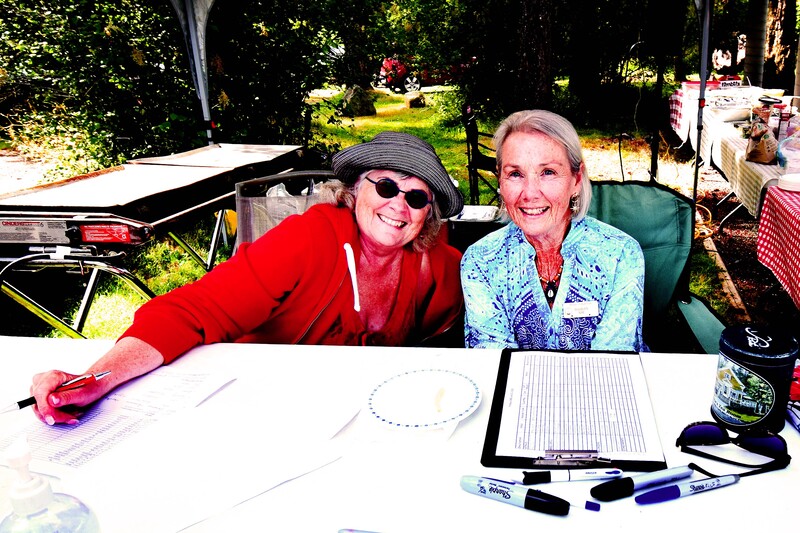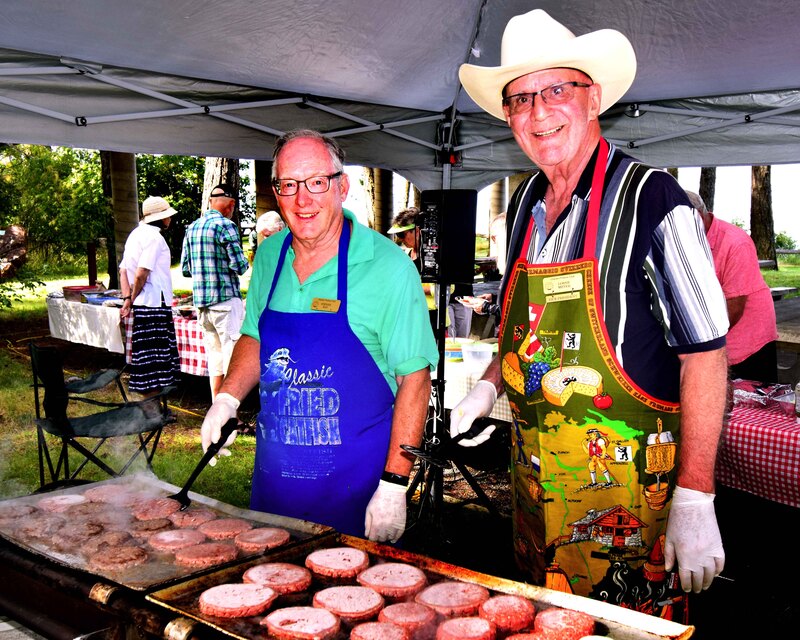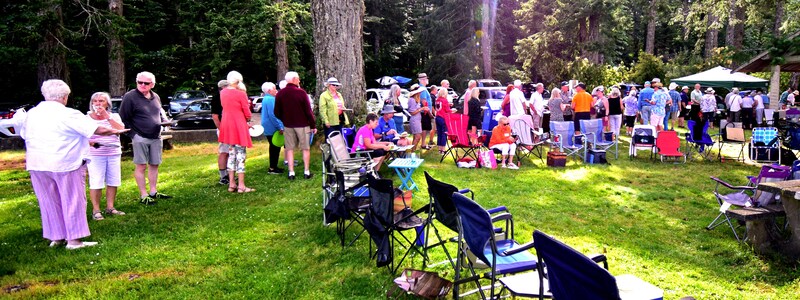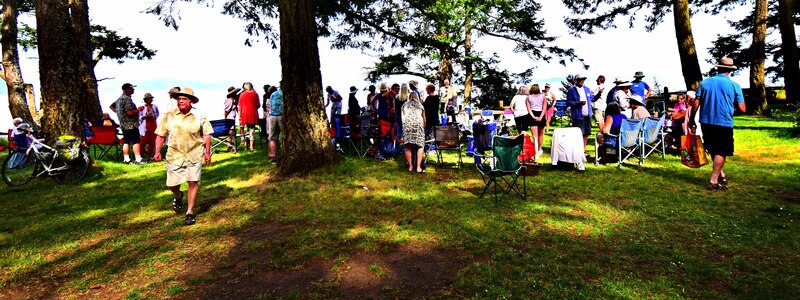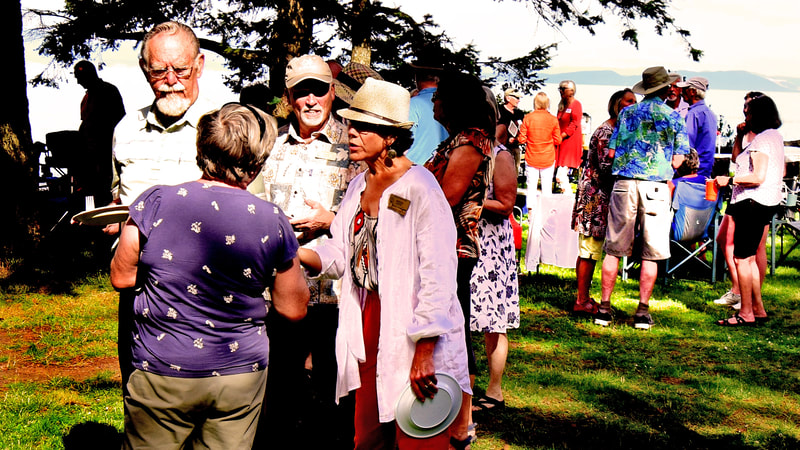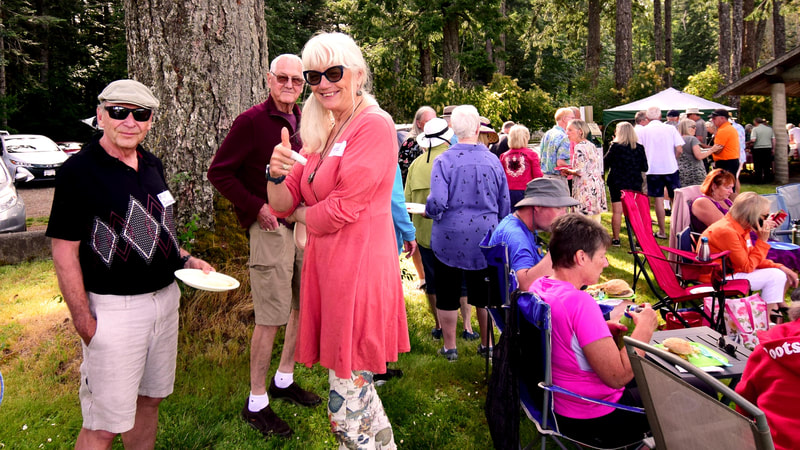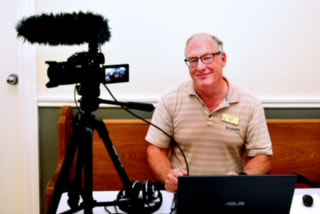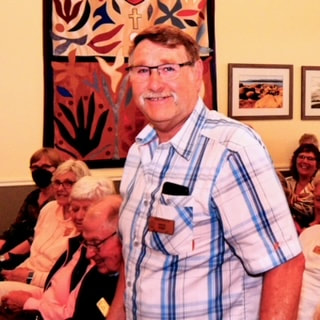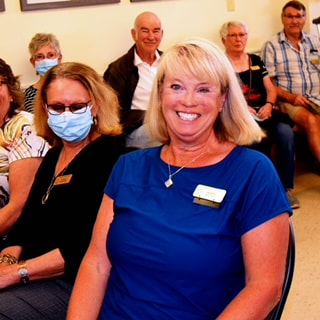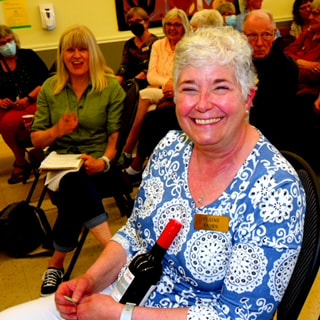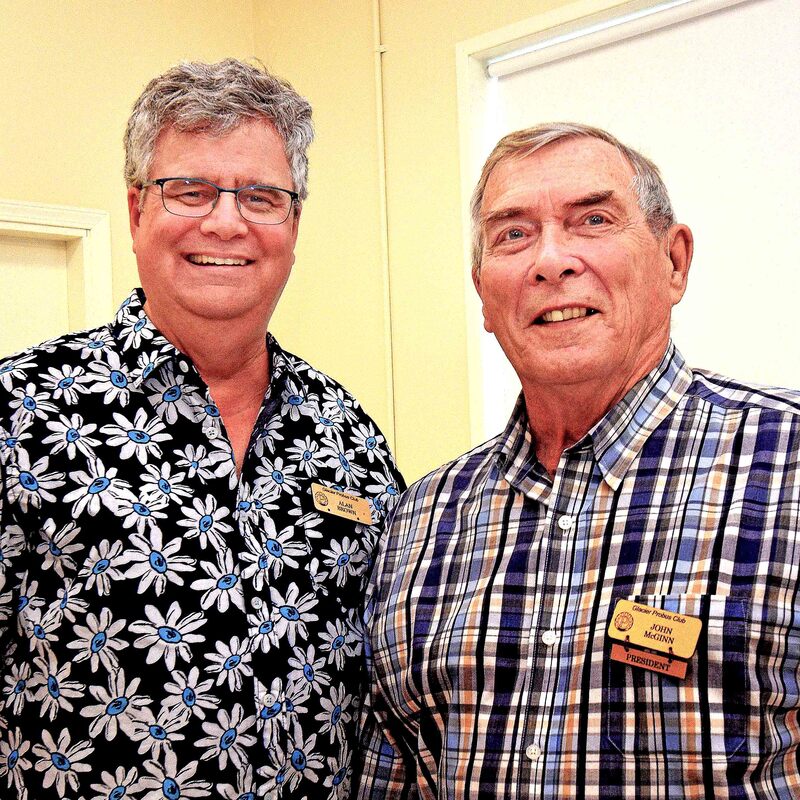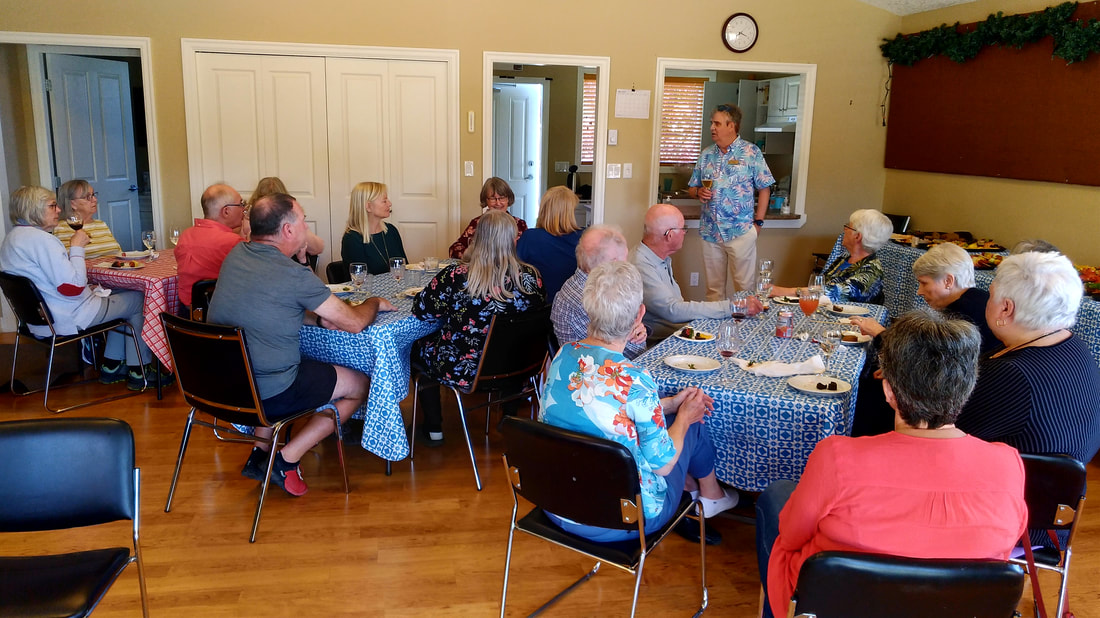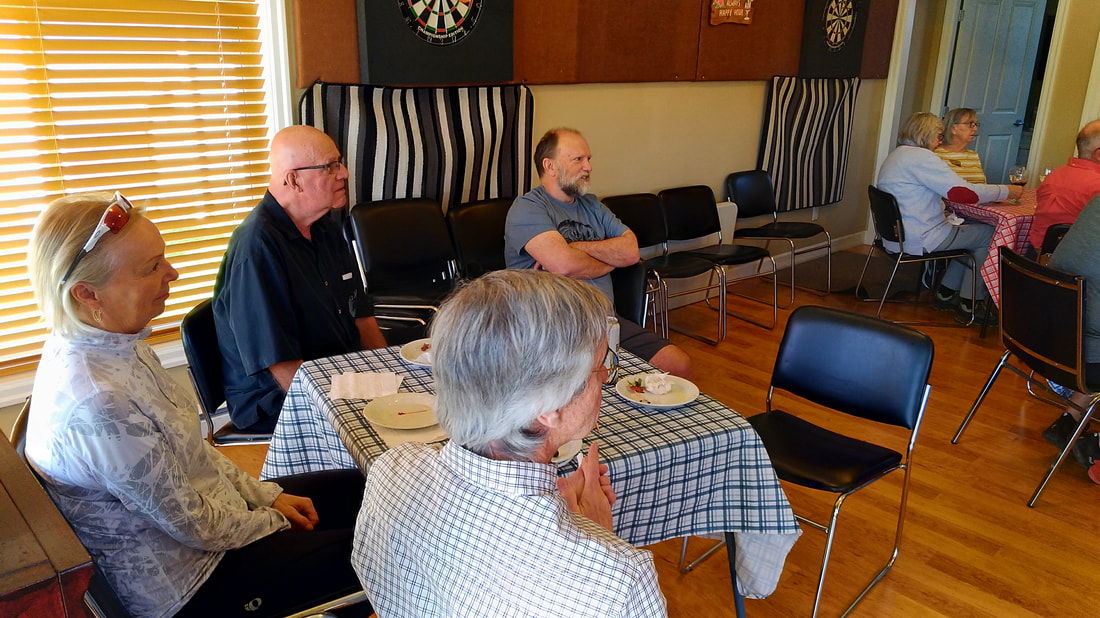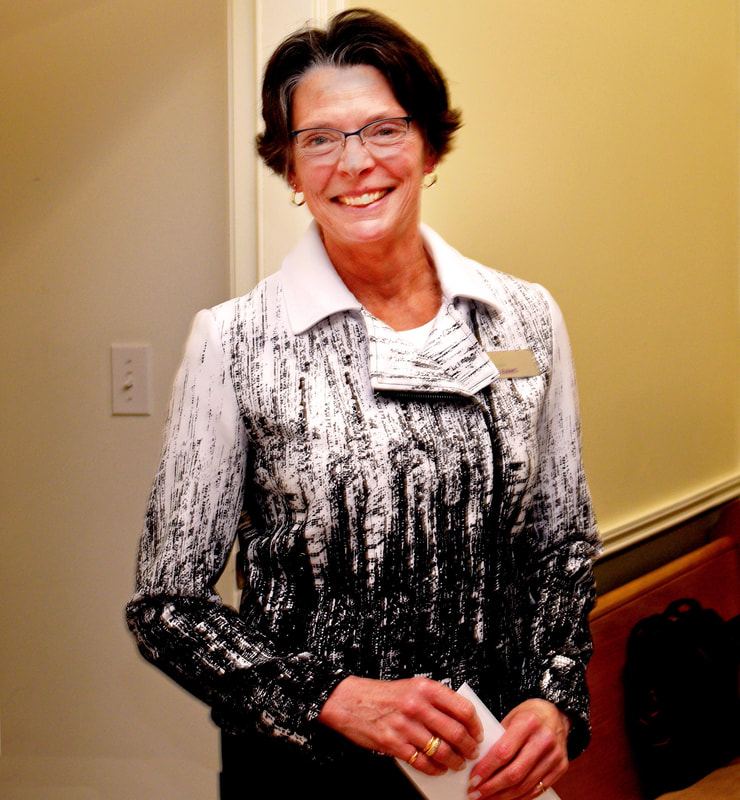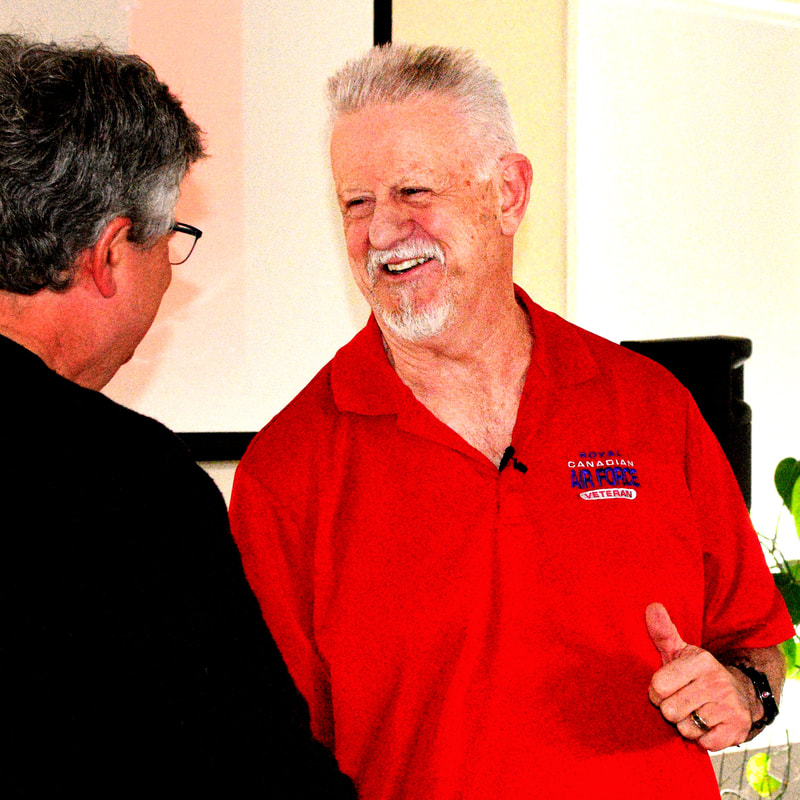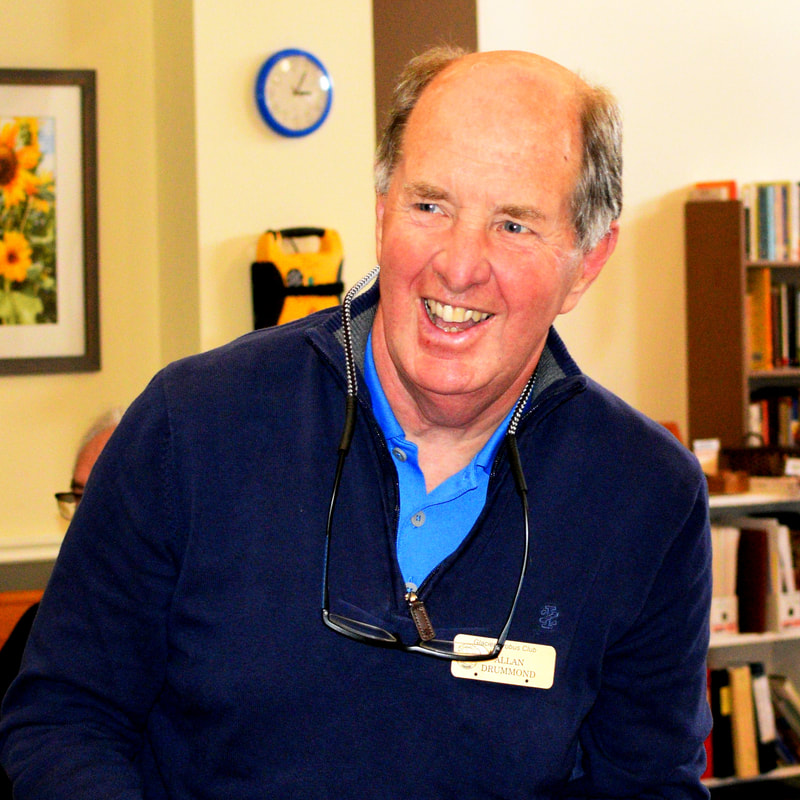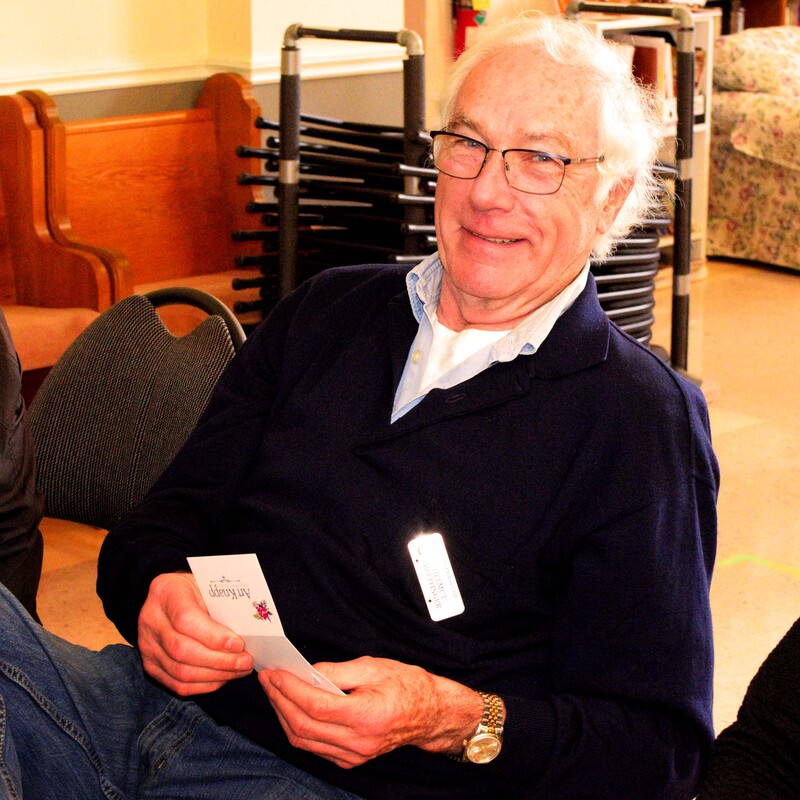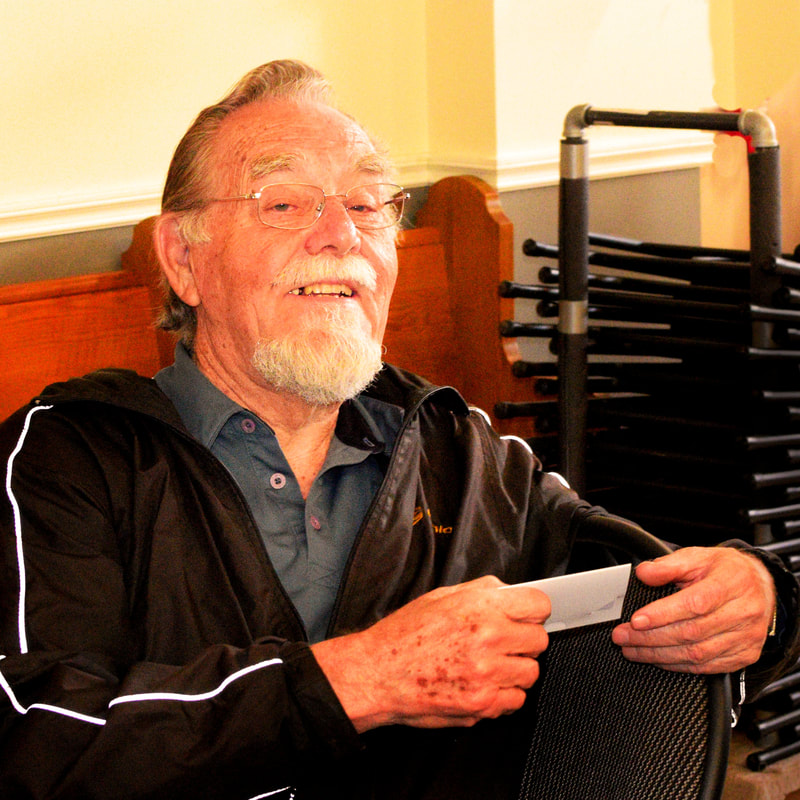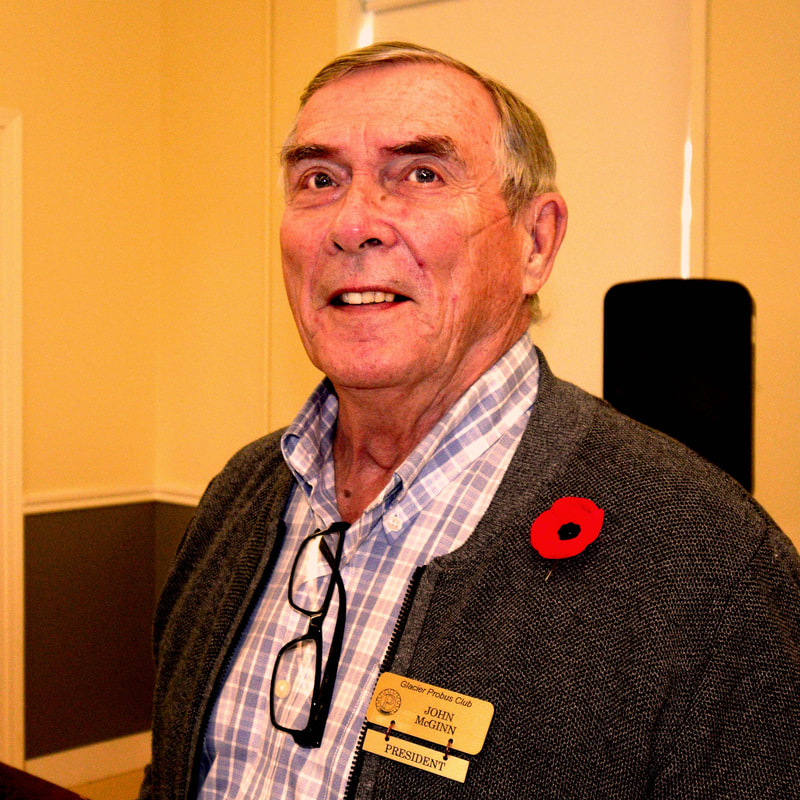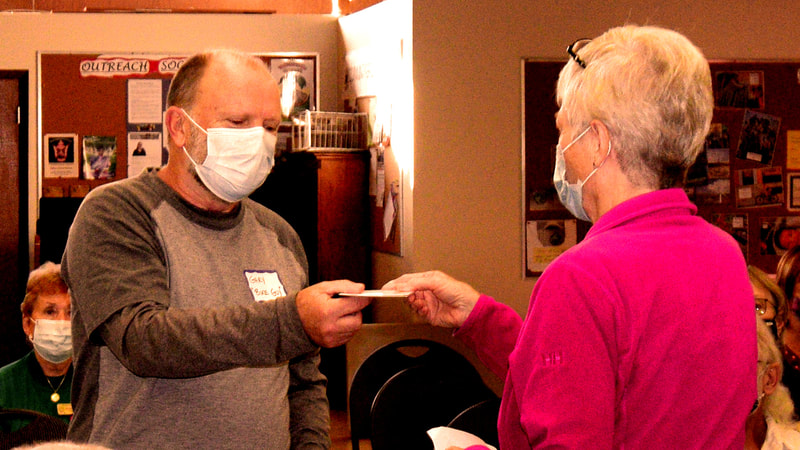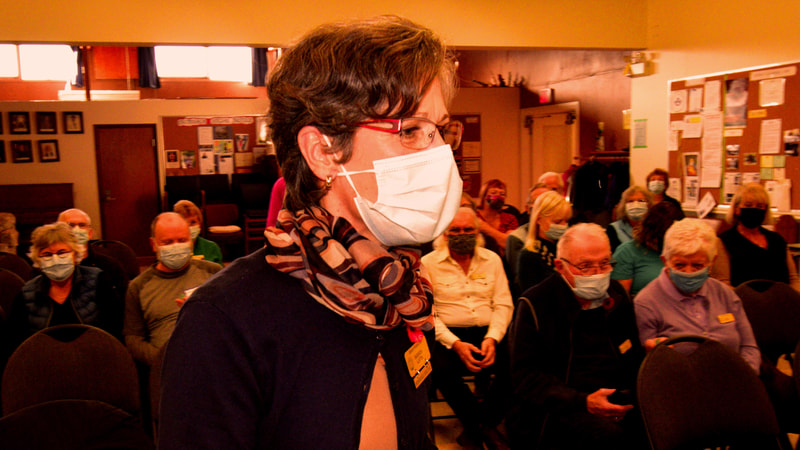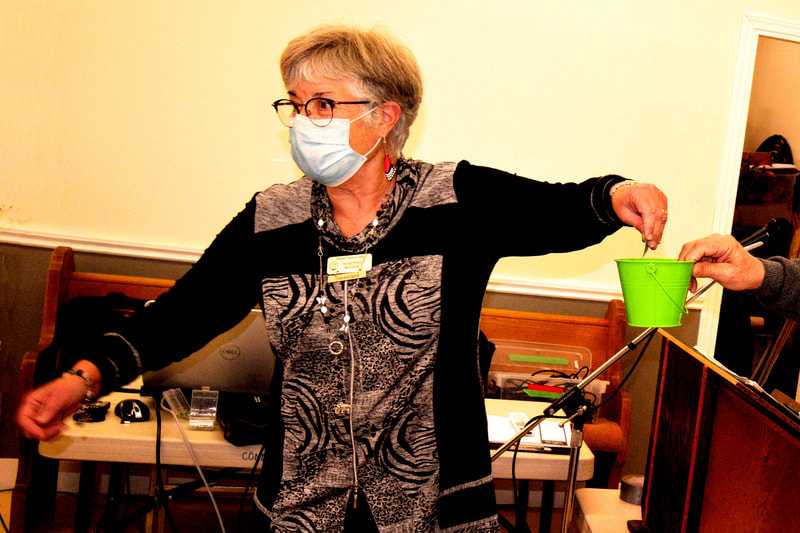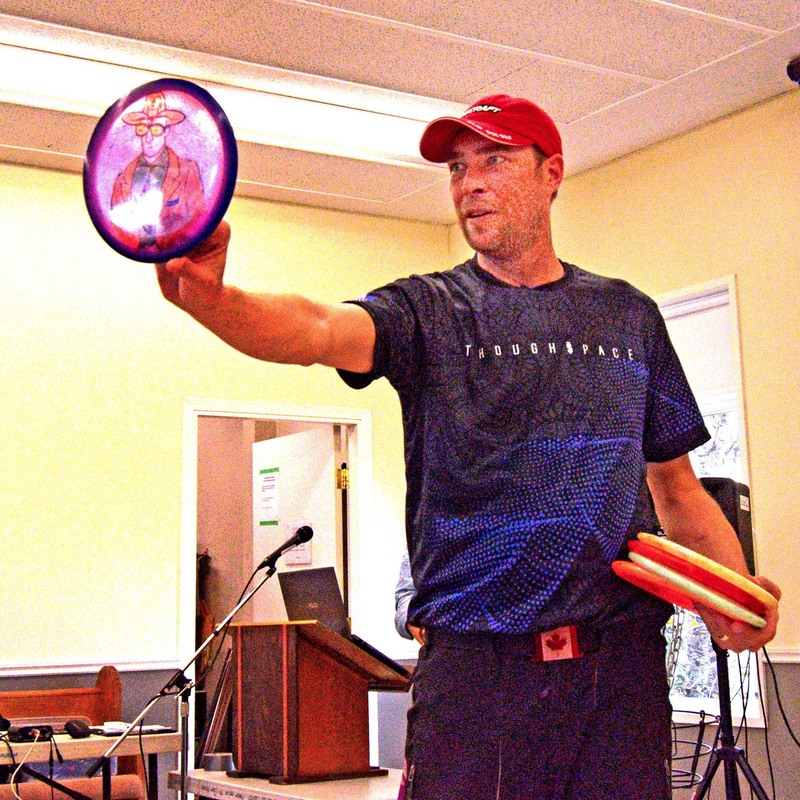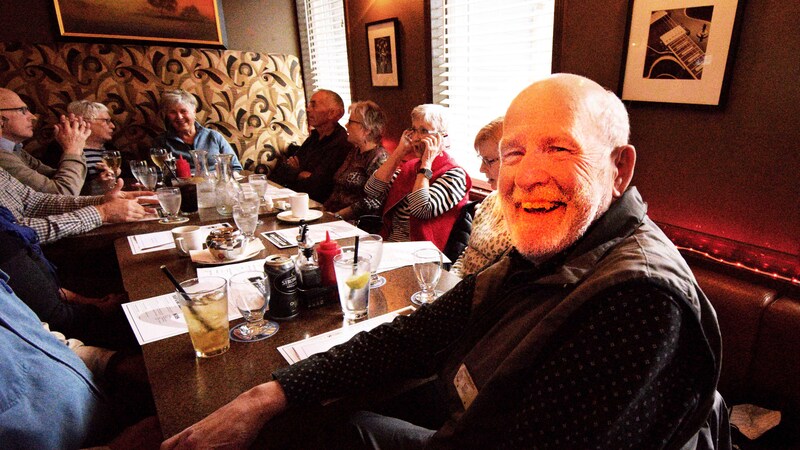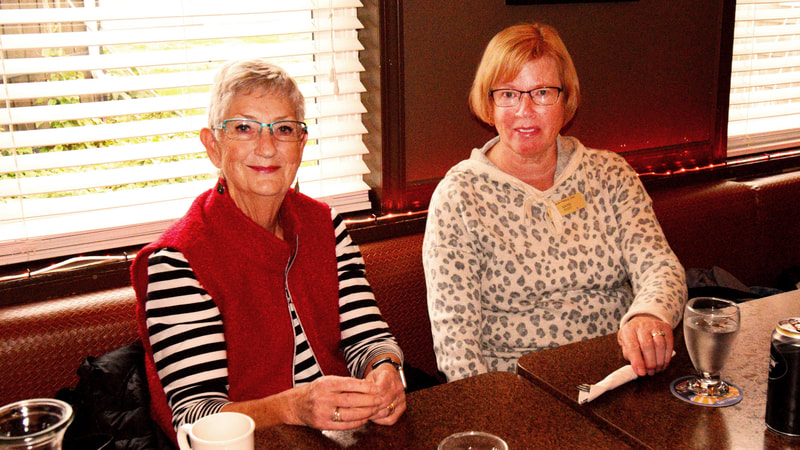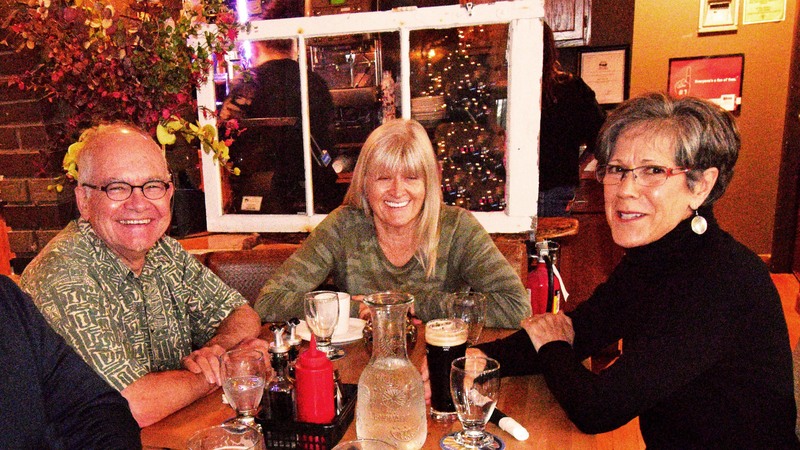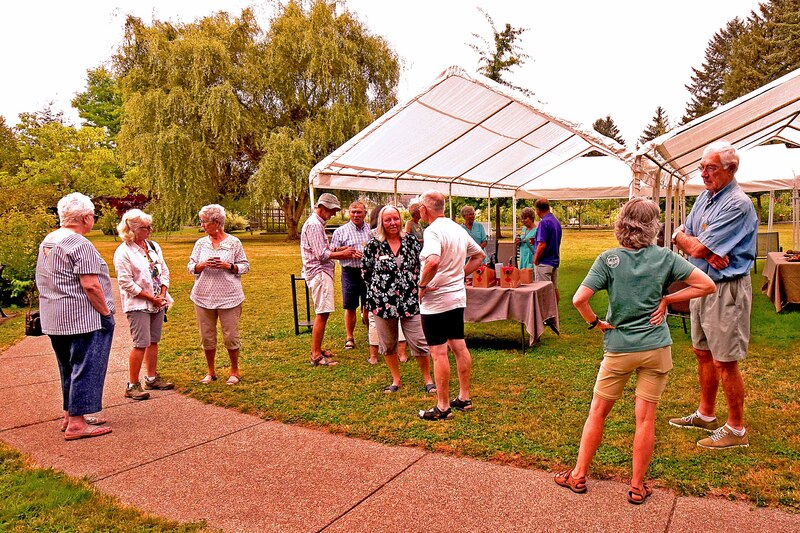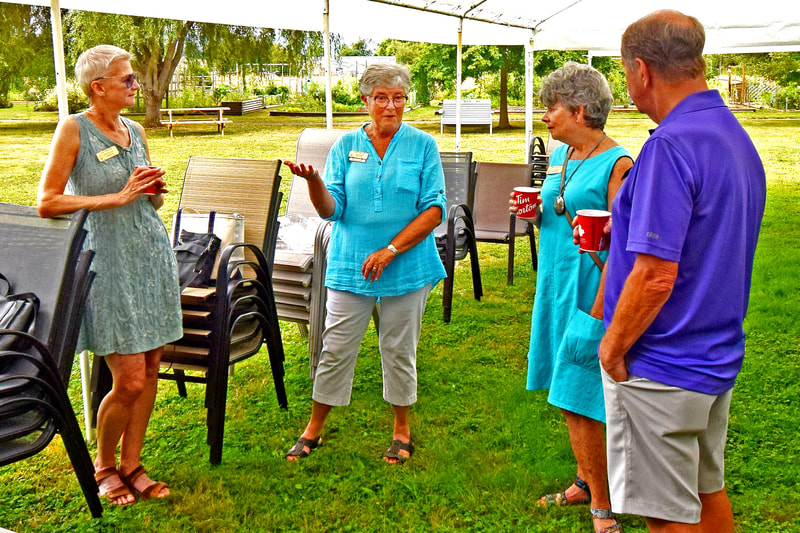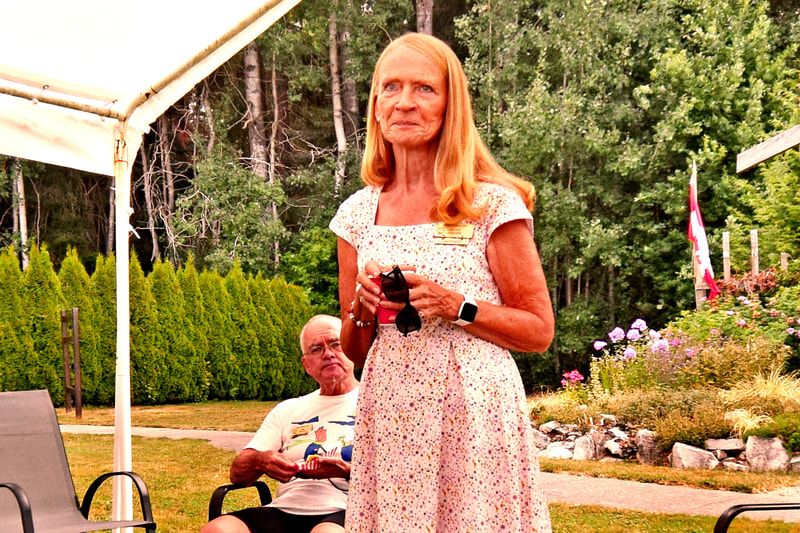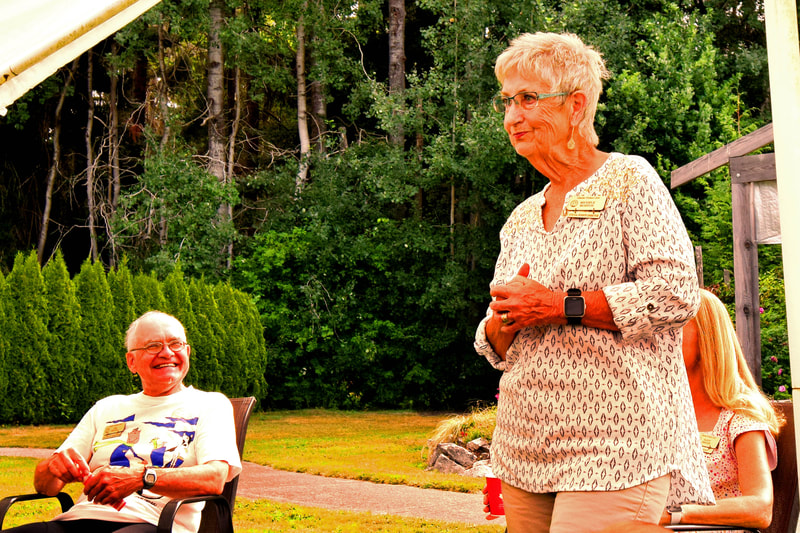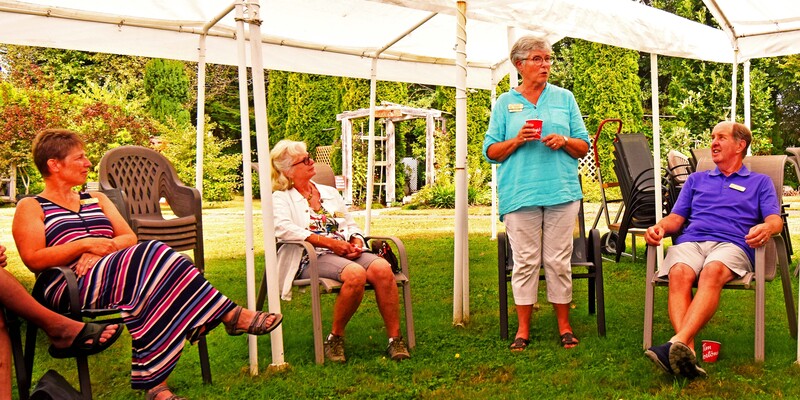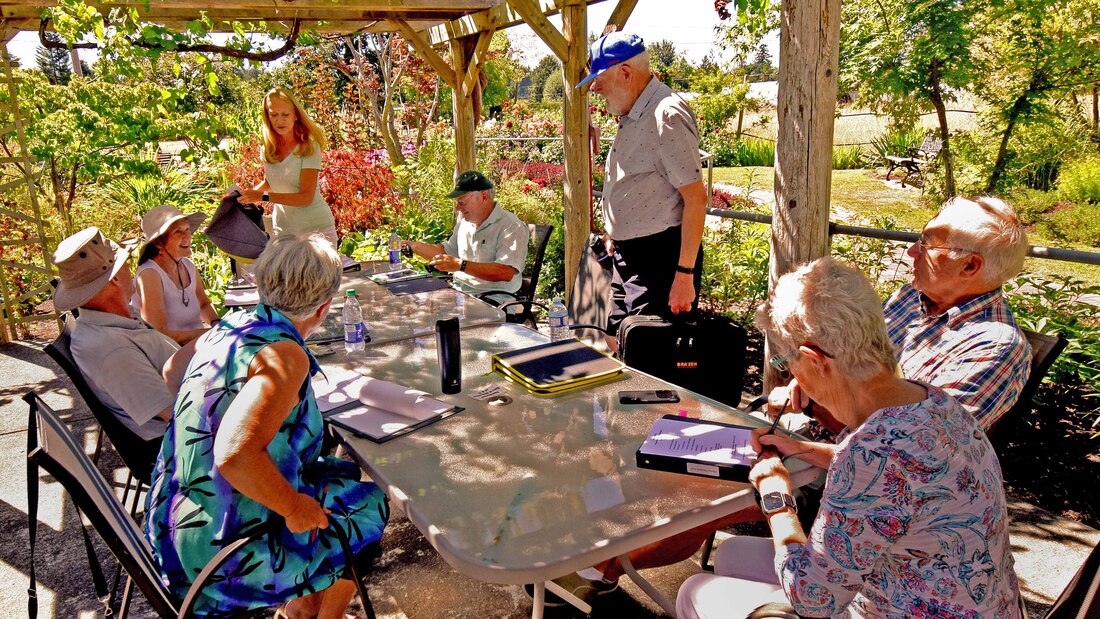|
78 hungry Glacier PROBUS members showed up at Kitty Coleman Park on the perfect summer BBQ day. Good food and good company was enjoyed by all. Thanks to Steve and Marilyn for organizing this. Steve and Lorne for the actual BBQing - with only one burner :(. Thank you for all the extras brought by club members. And a special thank you to the set-up and clean-up crew of Tina and Gary, Brian and Carla, Marilyn, and Jill and other helping hands. Vice President Alan Brown introduced Blythe Reimer, our guest speaker and the first Canadian female pilot to fly the Sea King CH-124 helicopter. At that time (the 90s) only 2% of pilots in the world were women but today 10% of pilots are women.
Blythe said that this was not planned nor something that she pursued, however, after graduating from University, she asked, “What am I going to do now?” Blythe humbly recounted her story neither wanting to dilute nor embellish her narrative. A ‘military brat’, her father and grandfather both pilots, the family moved every three years and she attended high school in Heidelberg, Germany. She spent 6 years in Paris at an American University and speaks English, French, German, some Spanish and Italian. Whilst at university in 1986-1988 combat training for women opened up and Blythe and a friend began their training at HMCS (Her Majesty’s Canadian Ship) Naval Academy in Esquimalt where she topped her course and served as Bosun for two years. It was there she developed a love of being on a ship. As a woman she stated, “it was just something I did”. Blythe first flew the Musketeer aircraft for 120 hours with 2 other women only one passing with the required 90%. The second ‘funnest’ part of her training was flying the CT-114 Tutor jet which the Snowbirds flew. Their motto was, “First you get good, then you get better”. That completed her fixed wing pilot training. Next came her rotary training on the CH-139 Jet Ranger, a single engine used to help RCAF (Royal Canadian Air Force) helicopter trainees earn their wings. Coming second in that course, the military decided she should get her wings and she graduated in June 1990. Following graduation she was sent to Squadron 406 Maritime Operational Training Unit in Halifax, Nova Scotia where she learned to fly the CH-124 Sea King helicopter. Blythe recounted landing the Sea King on a ship in rough water. Once the pilot has received permission to be over the ship, the landing begins. The pilot must stay level with an artificial horizon and line up between two black lines that run down the hangar doors with 5 feet of clearance. Then receiving permission from the landing officer the probe hooks onto the ‘Bear Trap’ and the helicopter lands. In 2002, Blythe retired to Airdrie, Alberta and became a nutrition coach. Her pilot husband worked for WestJet and they moved to Comox and decided to open a restaurant, The Tidal Cafe, in Comox. Blythe loves the support she has received from family, friends, and the community. Alan Brown thanked Blythe for her presentation. President John McGinn brought forward two matters concerning our AGM. The new Management Committee consists of: Alan Brown, President Lorne Meyer, Vice President John McGinn, Past President Dorothy McGinn, Treasurer Jill Almond, Secretary Donald Bourne, Registration Director Brenda Latta, Membership Director Jim Belair, Activity Group Director Ian Thompson, Communications Director Steve Ray, Technology Director Susie Wilson, Facilities Director Michele Morton, Special Events Director Helmut Breitinger and Marie Morck, Directors at Large President McGinn thanked the present Board for their work and appreciated everything they did. Vicki Matthews also thanked the Board for getting us through Covid. Treasurer Dorothy McGinn noted that our bank balance of almost $9000 will soon be increased with our 250 members paying their annual dues of $35 by July 31, 2022. The only unknown expense is the rental for the church. The major expenses of 2021-2022 were the meeting room rental, Co-ordinators appreciation event, and the retiring board appreciation event. Treasurer Dorothy McGinn noted that the 2022-2023 Glacier PrOBUS Club Budget must be ratified by a show of hands, all in favour showing approval of the Budget. Vicki Matthews moved that the 2022-2023 Glacier PROBUS Club Budget be approved as presented, with John McIsaac, seconding the motion. All in favour, motion approved. President McGinn introduced new members Dan and Dianne Needham. Winners of the Tidal Cafe gift certificates were: Steve Horn, Debbie Haynes, Sandra Wagner, and Phil Morck. Winners of the Wine bottles were: Dave Adshead, Marilyn Ray, and Elaine Brown. President John thanked us all for coming out and reminded us of the Summer BBQ and that there are still tickets for the PRISMA cruise. THERE WILL BE NO GENERAL MEETING UNTIL SEPTEMBER, 2022 Newly elected Vice President Lorne Meyer requested that members contact him with suggestions for guest speakers. The meeting ended at 3:00. There were 38 in person members and 9 members via the Zoom platform. Photos compliments of Ian Thompson: in order, Steve Ray, Steve Horne, Debbie Haynes, Elaine Brown and new President Alan Brown with Past President John McGinn, partial picture of new Management Committee. Several 2021 new Glacier PROBUS Club members joined some of the Management Committee for a long awaited Meet and Greet. Good food, hot drinks and good company were enjoyed by all. We learned about our new members and their interests and also a bit more about our MC members. There's Joanne (hope I've spelled that correctly) who is active in a local play at the Filberg Centre, Barb who is keeping busy gardening and volunteering for Anderton Gardens and the Georgia Straight Jazz Society, Stan, a hiker (and reluctant photographer), Dale our cyclist still recovering from his accident with more cycle trips planned, Dan and Dianne (the Double Ds) who moved here just before Covid and had a few rough and isolating years but now Dan has an art show at The Artful Gallery, and Dianne is busy with gardening and writing, and Rob who is also busy cycling and volunteering with SAR. If I have missed anyone I do apologize. Welcome to you all!
The event was a success with good food, drink, and company. 19 out of 26 coordinators attended. Thanks to Alan Brown for his heartfelt words of appreciation, and Lorne Meyer's interpretation of past President Sandy Dreger with a 'flick of his long hair' as he read Sandy's note of acknowledgement of our activity coordinators. Thank you to Anne and Ray Fast for making the Murrelet Strata Clubhouse available. Photos courtesy of Steve Ray.
President John McGinn opened the meeting at the Comox United Church by thanking everyone who came (37) and those who preferred the comfort of their own home via Zoom (7). He mentioned the following items:
President John then introduced our guest speaker, Jane Evans, a Development Officer for BC Cancer Foundation on Vancouver Island. Jane grew up in Winnipeg and has been on the Island for 21 years spending her leisure time walking on the beaches with her standard poodle. Jane Evans thanked us for coming out and noted how wonderful it is to meet in person once again. She said there is exciting news from BC Cancer in Victoria and the BC Cancer Foundation. The BC Cancer Foundation’s latest fundraising campaign slocan is: THIS IS PERSONAL. Who are we The BC Cancer Foundation is BC Cancer’s fundraising partner. The BC Cancer agency provides care and treatments, while the BC Cancer Foundation fills the gap with equipment, research, and patient support. All funds raised by the BC Cancer Foundation stay in BC and the Yukon. Our Vision A world free from cancer. We are not The BC Cancer Foundation is not: The Canadian Cancer Society which is a National organization with headquarters in Toronto. Those funds are distributed across the country for lodges, education, and research. BC Cancer Foundation in Victoria, BC Provides world-class comprehensive cancer care and treatment close to home. The building is by the Royal Jubilee in Victoria and is a light-filled, natural wood building with all chemo and radiation treatments above ground. World-class research and treatment are available today with the latest equipment and technology.
The Foundation is just wrapping up a $5M fund-raising campaign for a PSMA PET-CT imaging unit which provides specific prostate membrane imaging that will support an earlier and more accurate detection of prostate cancer spread. Currently this is only available in Vancouver one day a week and the wait-list is 8-12 months. The “World Is Watching” as Phase Two of the Immunotherapy Trials begin for blood cancers. These super-charged T-cells are created in Victoria at the Deeley Research Centre. It is hopeful that immunotherapy will provide a new and improved treatment for a wide spectrum of cancers. Patient Care is focusing on a safer more culturally sensitive Indigenous environment with artwork, and healing spaces. Provincial Initiatives What excites our oncologists the most is genomics-the study of cancer at the cellular level of the tumour cells based on a patient's genetic makeup resulting in a personalized approach to care. Hence the BC Cancer Foundation slogan: THIS IS PERSONAL. For more information check out Ian Thompson's email from Jane Evans with PDF attachments on: Breast Cancer, Immunotherapy Clinical Trials, Gynelogical Cancers, Genomics - Future of Cancer, and PSMA-PET 2. If anyone has any further questions do not hesitate to contact Jane Evans: jane.evans@bccancer.bc.ca Tour de Cure This is the biggest fundraiser and in 2021 it raised $5.5M with 3250 riders. This year it will be in Chilliwack on August 27, 2022 with rides of 50km, 100km, or 150km. Check out: www.tourdecure.ca To be part of the day, one can ride their own 50, 100 or 150km and share throughout the day on social media. One can also track their route and share it using the Strava App. If you have any questions contact Lindsay Carswell at lindsay.carswell@bccancer.bc.ca Advanced research and equipment is supported by monthly or annual giving, gifts of shares, and gifts in wills or estate gifts. Jane Evans ended her informative session by thanking everyone and noting that: THE PROGRESS IS REAL. President John thanked Jane for her presentation. The winners of the Church Street Tap House gift certificates were: Sheila Precious, Jim Belair, Ann Fast, and Ian Thompson. Photo of Jane Evans compliments of Ian Thompson. Held in the Comox United Church with 29 people in attendance and another 9 on the Zoom platform.
President John McGinn opened with a great joke! He noted that the Annual General Meeting will be on June 2 and that some positions are opening on the Board. For more information contact past-president, Sandy Dreger. The Summer Barbecue is scheduled for July 21 at Kitty Coleman, the Christmas Dance is on December 3 at D’Esterre, and PRISMA will be held on June 25. Another Bowling date has been added for April 23. Sign-up on the Special Events page of our Website. Vice-President Alan Brown talked about flying into Comox 25 years ago and finding a “huge air base, rolling past CF18s, and Search and Rescue (SAR) planes and wondering why an Air Force (AF) Base was in Comox". When he became vice-president, he was determined to find the answer, introducing our guest speaker, retired Colonel Jon Ambler of 19 Wing Comox. Col. Ambler joined the Canadian Forces (CF) in 1979 and took command of 19 Wing Comox in 2004. In 2006 he was appointed an Officer in the Order of Military Merit. He served 30 years in the AF as a Long Range Patrol Navigator. He commanded at the Crew, Flight, Squadron, Peacekeeping Task Force, and Wing levels. Retiring in 2007, he has been very active volunteering for the Comox Valley Air Force Museum and researching and promoting BC’s aviation history. Col. Ambler noted that as a historian, he usually holds public speaking engagements monthly but has done nothing but Zoom for the past two years and that it was a great pleasure to be here in person today. The airfield at Comox was opened by the Royal Air Force (RAF) in 1942 to provide a base on the West Coast with the best weather for the Torpedo bombers to fly over the Pacific looking for Japanese warships. With the reduced role of the Torpedo, the Royal Canadian Air Force (RCAF) took over the base in 1943. Wartime Role and Training: #6 Operational Training Unit (OTU) was a Transport Establishment that flew the D-47 Dakota built in 1930, "with a design that was almost perfect, with some still flying today”. The crew was trained to support the British fighting the Japanese and flew to China, Burma, and India over the ‘Hump’ of the Himalayas. It could transport 30 crew who would parachute out the back of the plane. The Dakota also towed Gliders, also used in WW2, out of the Cassidy RCAF glider training base now the Nanaimo Airport. Long Range Patrol: In 1946 RCAF Station Comox was closed under the direction of the Department of Transport. In July 1952 Comox was reactivated with the first operation squadron, 407 Maritime Patrol Squadron flying the Lancaster whose primary task was in anti-submarine warfare role. They provided undersea surveillance, operations against terrorism, high seas driftnet fishing patrols, counter drug ops (with RCMP) and SAR. In alliance with NATO and NORAD they patrolled the Pacific and Western Arctic Ocean. The Neptune replaced the Lancaster and was eventually replaced by the Canadian built Argus capable of flying for 10 hours over 3000 miles. Air Defense: In November of 1954, the 409 All Weather Fighter Interceptor Squadron was reactivated at Comox due to the threat of the Soviet Union Bomber Force. Over the years it was equipped with the CF-100 Canuck (nicknamed the "Clunk") which was replaced by the CF-101 Voodoo till the 1980s. These supersonic planes were built in the USA and were armoured with a nuclear unguided 'Genie' rocket warhead to fire at bombers. The acquisition of nuclear weapons resulted in both political and anti-nuclear controversy and protests. The purchase agreement actually states that the ‘Genie’ rockets were the property of the US and that Canada would only use them under the North American Aerospace Defense Command (NORAD) 1957 military alliance with the US providing aerospace warning, airspace sovereignty, and protection of North America. They were never used. In 1984 409 Squadron ceased Voodoo operations at Comox and moved to CFB Cold Lake to fly Hornets. Today, Comox remains a NORAD Forward Operating Base (FOB). SAR: The 442 Transport and Rescue Squadron conducts SAR operations and Cormorant training. Their designated ‘Victoria’ region of the Canadian Search and Rescue Regions (SRR) is the smallest at 1.3 million square km comprising BC and the Yukon but the busiest SRR with over 300 calls per year covering the most diverse landscape (mountains, ocean, forests, lakes, trees, and coast line including the Arctic). Col Ambler noted the helicopter is best used for the rescue part of SAR. The Albatross, which was an amphibious helicopter, was replaced by the Labrador which was notoriously underpowered with two engines and no warning other than “the earth was getting closer” when one engine shut down. The Labrador was replaced by the Cormorant and with three engines and a light that notifies when one is lost, it currently provides the best SAR capabilities at the Squadron. The helicopter holds a pilot, co-pilot, flight engineer (that manages the hoist), and two SAR Technicians with paramedic training. The Buffalo, a SAR airplane, has just been retired and replaced by the Kingfisher that carries a pilot, co-pilot, sensor operator (including radar, infra-red, lowlight, and TV) operator, and navigator. The Kingfisher is used for sensing humans which from 200 feet away are the size of a soccer ball. It can fly at night and in bad weather. SAR Techs, the Air Force Para-Rescue Specialists, moved their school to 19 Wing Comox in 1996. The Canadian Forces School of Search and Rescue (CFSSAR) opened in Comox in 1998, training crew and maintenance personnel using simulators and aircraft. The 418 Squadron was Canada’s highest scoring squadron in WW2 in terms of day and night operations. It was re-introduced in 2019 as the 418 SAR Operational Training Squadron and began operations at the new SAR Centre of Excellence Training Center at 19 Wing Comox in 2020. Their training methods and new simulators will improve SAR skills using the latest fixed wing search and rescue aircraft, the Kingfisher. Col. Ambler invited us all to come to the Museum for more detail. 2024 marks the Centennial for the RCAF and the Museum is hoping to raise enough funds to build a display for a 1999 Vampire. Col. Ambler answered the following questions: The myth of the Avro CF-100 Canuck. The Government cancelled the project of a more futuristic/triangular updated version in the 1950s as the RCAF did not want the plane as there were other planes already flying that were just as good plus if they trained squadrons for the new Canuck there would be no money for anything else. The ‘Genie’ nuclear 1.5 tonne nuclear warheads were sent back to the US. Planes use jet propulsion fuels based on either naphtha or kerosene with different additives. The SAR community includes the Coast Guard, the RCAF, the RC Navy, the RCMP, local police, North Shore Rescue, and volunteers. On behalf of Glacier PROBUS, Alan Brown gave Col. Ambler’s honorarium to the Museum at his request. Alan noted that Ms. J. Evans from BC Cancer will be our May guest speaker and will report on new cancer care on Vancouver Island. President McGinn thanked Col. Ambler for a most informative talk and announced the winners of the Art Knapp gift certificates who were: Bev and Gerry Haist, Dave Adshead, Helmut Breitinger, and Alan Drummond. The March 3, 2022, General Meeting was held at Comox United Church with 28 people attending in person and another 14 members via the Zoom platform.
President John McGinn welcomed everyone and noted how wonderful it was to see everyone. He is hopeful that in a few months we may be back to where we once were with more faces and coffee and snacks. President McGinn welcomed Judy Murakami, the President of the Strathcona Probus Club in the Comox Valley. He also introduced a new Club member, Bruno Antonello who has a background in radio and television. A joke followed with President McGinn turning the microphone over to Alan who introduced our guest speaker, Ross Moxley, a gifted storyteller. Ross was a grain farmer for 5 years in Saskatchewan and in his down time studied law. He was appointed to the Provincial Court in 1969 and was known as the “Flying Judge”. Ross recounted many tales of his life in his speech to our Club. Alan Brown thanked Ross for sharing his exciting life story. The winners of the Laughing Oyster Book Store Gift Certificates were: Jeannie Hall, Jim Belair, Steve Ray, and Leslie Fraser. President McGinn thanked Donna and also Ross for his enlightening speech. He ended the meeting hopeful that next time we will be back with more of our friends. The February 3 General Meeting was held via Zoom with 40 members attending.
President John McGinn thanked Alan and Elaine Brown for putting in the time and organizing our meeting. Alan Brown introduced our guest speaker, Adam Taylor, Executive Director of the Marmot Recovery Foundation since 2015. Previously, Adam worked in other species recovery programs such as endangered shark-tailed snakes, bats, turtles, and slugs. Without the ground efforts of the Marmot Recovery Foundation, funded by landowners and individual donors, the wild population of the Vancouver Island Marmot would be gone. The Vancouver Island Marmot is totally unique to Vancouver Island and is one of the largest members of the squirrel family (about the size of a large house cat). However, the VI Marmot is an “upside down” squirrel with powerful shoulder and leg muscles for digging. MARMOT HABITAT VI Marmots live in south and west-facing sub-alpine and alpine meadows where avalanches and snow creep clear the bowls and chutes from trees. These tree-free open meadows are filled with grasses and flowers which this herbivore loves. These areas are also the first to be free of snow and produce early grasses when the marmots emerge from hibernation in the spring. When not eating, the VI marmot stretches out on boulders, watching for predators such as cougars, wolves, and golden eagles, announcing their arrival with a shrill whistle and a scurry into an escape burrow. HIBERNATION The VI Marmot lives in family groups called colonies and hibernates below the frostline for 7 months from mid-September till late April or early May. During this time their metabolic rate slows down, Adam describing them as “freeze dried”. Their breath rate slows to 1-2/minute, and their heart rate from their usual 110-200 beats per minute to 4-8 bpm and their body temperature drops to 4-6 degrees Celsius. They lose 30% of their body mass during this period. However, they do wake up every two weeks for a bathroom break and these brief, wakeful periods use up 80% of their energy. Come spring, when they emerge, they often tunnel through several meters of deep snow, and it can take two weeks for their digestive system to “wake up”. They are most vulnerable to perishing during this time from a lack of energy also making them easy prey. The mature 3+year old female marmot is pregnant for one month giving birth to 3 or 4 pups once every two years. The pups spend their first month inside their burrows emerging in late June or July. The pups stay with the mom for two years. The marmots hibernate as a family although the father may have several different long-term relationships. ECOLOGICAL IMPORTANCE VI Marmots are great pollinators and they play an important role in turning over soil making nutrients available. Their network of burrows provides hibernacula for western toads and garter snakes. DISPERSAL VI Marmot colonies are small with usually 2-4 marmots made up of family members making mate selection difficult. VI Marmots live in networks of colonies called “meta-populations”. Therefore, marmots leave their home colony in search of a colony nearby or else they attract a mate coming from another colony. This movement between colonies is called dispersal. A usual dispersal range is 5-20km, but one tracked male dispersed 27km which may explain the two lost marmots-one found in a wood pile at Qualicum Beach and the other on the beach at Bamfield. Dispersal allows new colonies to be formed and replenishes declining colonies keeping the VI marmot population healthy. HISTORY DNA evidence suggests that the first VI Marmot arrived around 100,000 years ago. Marmots played an important part of First Nations history. They were hunted annually for their fur and meat, and they played a role in their spiritual life. This would suggest that the marmot population was once quite large and widespread. DECLINE In 1978 the VI Marmot was an endangered species and in the mid-1990s the population was in serious trouble. In 1998 only 70 marmots were recorded in the wild with only one small colony on Mt. Washington and the others east of the Nanaimo Lakes. It isn’t known with certainty why marmots were disappearing, but their core habitat is small and patchy, and colonies have relied on dispersal efforts to maintain their population. However, roads and dams may have impaired their ability to disperse and their ability to rescue each other. The cottontail rabbit was introduced to Vancouver Island followed by its predator, the Golden Eagle, which now has an established population here. Predators account for 80% of the VI Marmot decline. RECOVERY The Marmot Recovery Foundation was founded in 1999. The Recovery Team launched a rescue effort of captive breeding combined with the release and reintroduction of captive-born marmots to the wild. Without this program the Foundation felt that the VI Marmot would become extinct. As of 2020, they have released 550 captive bred VI Marmots. Two colonies have dispersed and created their own colonies. There are now 70-80 marmots in Mt. Washington and Strathcona Provincial Park. Each year the Foundation supports growing colonies by releasing marmots. They also rescue lost marmots or those in danger. Furthermore, they monitor the wild population with radio telemetry and provide high energy food for their emergence in the spring. FUTURE FOR MARMOTS The VI Marmot is one of the rarest mammals in the world. Climate change over the past 20-30 years has produced a change in tree cover which has increased in the marmots habitat by 25%. But thanks to the recovery efforts, the VI Marmot population has increased from less than 30 wild marmots living in a handful of colonies in 2003 to 250 (an increase of 50 from 2020-2021) living in over 20 mountains. HOW TO SPOT THE VI MARMOT AND WHAT YOU NEED TO DO The VI Marmot spends early mornings and late afternoons lounging on top of rocks looking downhill for predators. They have chocolate brown fur with which patches on their nose, chin. forehead, and chest. On Mt Washington they live right on the ski slopes (which are “artificial avalanche” areas). You may find a pile of dirt and rocks which is the front porch of their burrow. Or you may see emergence holes from their hibernacula in the spring snow. If you see one: take a photo, record the location or GPS coordinates, ear tag visibility and please let the Recovery Team/Foundation know of your find. On behalf of Glacier Probus, Alan Brown reported a donation will be made to the Marmot Recovery Foundation. You can visit their website at: https://marmots.org Or join The Adopt A Marmot Club! President John thanked Adam for a most interesting presentation and reported that when he was on the chair lift at Mt Washington he saw a marmot. The winners of Hot Chocolates Gift Certificates were: Gerry Haist, Ian Thompson, Jeannie Hall, and Robin Harrison! President John again thanked everyone and noted it would be wonderful to meet in person in the Spring. The January 6, 2022, Glacier PROBUS General Meeting was held on the Zoom platform with 36 members present.
President John McGinn welcomed everyone to PROBUS 2022 which is looking much like 2021. He hoped everyone had a good Christmas and New Years and he is looking forward to when we can meet in person again, but it doesn’t look like it in the near future. Jim Belair brought us up to date on a member hoping to start a Skiing Group. However, due to low interest the member has since decided not to pursue it. Tricia Nicol reported that the Bridge Group is once again playing virtually. Donna Crozier said that today’s winners of $25 Cobb’s Bakery gift certificates (with a surprise included!) may use their certificates tomorrow. Alan Brown introduced our two guest speakers, Carol Tyson and Adele Einarson, who since retiring in 2020 after 30-40 years as Registered Nurses, have become very active in the local ElderDog Canada Chapter or Pawd as they are called. Carol is the Leader and Volunteer Coordinator and Adele is the Treasurer and Education/Outreach Coordinator of the ElderDog Comox Valley Pawd. Adele stated ElderDog Canada is a national non-profit organization that was started by Ardra Cole, a University Professor, in Nova Scotia in 2009. Her research on caregiving and Alzheimer’s and dogs providing optimal companionship at the end of life combined with her own brother passing and leaving his dog, Mr. Brown, led to the beginning of ElderDog Canada. Mr. Brown is now the poster dog for ElderDog Canada. The organization is founded on three principles: 1. Comfort – to senior’s lives and the connection they enjoy with their dogs. 2. Quality of life – to live together in a healthy, mutually beneficial relationship. 3. Tribute – acknowledging how deeply the affect dog’s have on seniors’ health and well-being. In 2016 the organization became a Registered charity with no paid positions. All funds come from donations, fund raising (such as the local bottle drive in June), and the sale of dog food and Calendars. Currently the local Pawd is using funds to cover the recent Christmas Parade, and the purchase of safety vests for Volunteers and for emergency situations. Veterinary bills are paid for by National Headquarters. For donations to the local group, you can email Adele Einarson at: elderdogcvtreas@gmail.com. Nationally there are 29 ElderDog Pawds with three on Vancouver Island. Carol noted the Comox Valley Pawd started in February 2021 with 45 volunteers and now has 95 volunteers serving 16 clients and 19 dogs. The volunteer ages range from their 20s to 70s. The local Pawd serves Parskville and north on the Island. Their Facebook page is: Elderdog Canada Comox Valley Pawd. The volunteer email is: elderdogcvvol@gmail.com. The National Head Quarter website is: www.elderdog.ca. The Head Quarter 24-hour phone number is 1 855 336-4226. Any one can call this number, and their request/concern will be forwarded to the local Pawd. The National Facebook page is: https://www.facebook.com/ElderDog. Check out their store: http://www.elderdogcanadastore.ca. The Pawd provides free assistance for healthcare, exercise, and feeding with the aim to “keep love in the home.” Included services are simple hygiene such as brushing and nail trims, transportation to the Vet, temporary foster care, and finding forever homes for older dogs left without a home. The organization is also dedicated to the support, education, and research into the role that dogs play in the health and well-being of our seniors. During Covid, ElderDog has been deemed an essential service. Typically, a Dog Support Coordinator meets with the client and dog. The client and dog are then entered into the National Database and a care plan is developed. Dog walking is the main care required with requests for up to three times a day walks, or once a week in rain, wind, or snow! For anything from puppies to elder dogs. Not all meetings with clients result in immediate help. Clients and their families are pre-planning in the event of needing help down the road which allows the Dog Support Team to get to know both the client and their beloved dog. All volunteers have had a criminal check and wear ID tags. The clients have a magnet on the fridge and an ID sticker on the door to notify personnel that an ElderDog lives there. The local Pawd also collaborates with a Social Worker and a Senior Care representative at the hospital. Several local veterinarians have also given their support. Carol noted it is truly heartwarming the difference this organization can make. The local Pawd is still getting the word out there about their organization and this was their first community/public presentation. President John McGinn thanked Carol and Adele for their informative presentation. Treasurer Dorothy McGinn announced the winners of the gift certificates who were: Sheila Precious, Donna Crozier, Robin Harrison, and Jill Hatfield. President McGinn thanked Donna for arranging the gift certificates and Al for organizing the meeting and arranging the speakers. President McGinn ended the meeting once again hoping we can all get together soon and thanked everyone for showing up. On Thursday, November 4, 28 members in person and 12 members on Zoom joined together for our monthly meeting. Members were greeted at the door by Donna Crozier and her team who were checking Vaccine Passports and IDs. President John McGinn thanked members for coming and said that it was good to be back in person after 19 long months. He stated that despite the struggle, we have persevered thanks to Jim Belair and the cadre of Activity Coordinators whose work is much appreciated. Following in Past President Tony’s footsteps, President McGinn finished with a funny joke. Vice-President Alan Brown introduced our speaker, Ian Thompson. As Remembrance Day draws near, Ian Thompson presented his power point presentation on the involvement of the Comox Valley Communities during WW1. Many Canadians signed up to fight overseas in the first two years of the war including several men from the Comox-Atlin riding which included Hazelton in Northern BC to the Lower Mainland. This was a huge area to draw from and the men were a tough bunch of independent loggers, farmers, and fishermen. These men formed the 102nd Battalion of the Canadian Expeditionary Forces. They came to the Goose Spit for training where there was no electricity, no water, and the food was poor with the men living in teepee like tents. In June 1916, the 102nd Battalion boarded a steamship from the Comox pier to Victoria, then by train to the Canadian Forces Base in Valcartier, Quebec and finally to England. The 102nd Battalion fought in France and Flanders until the end of the war and were one of the divisions involved in the Battle of Vimy Ridge. One member, Lieutenant Graham Thomson Lyall was awarded the Victoria Cross for his actions at the Battle Du Nord. There were 3863 members; 676 died and 1715 were injured. This battered bunch were the occupation forces after the War. The 102nd Battalion disbanded in 1920. In 1917 the federal government decided to conscript young men for overseas military service as Canada was struggling to maintain voluntary troop numbers. Ian spoke briefly about Albert “Ginger” Goodwin who was a coal miner in Cumberland and fought for workers rights and was against military conscription. He led many strikes and was an organizer of the Socialist Party of Canada. He was killed in 1918 possibly from an accident or for his political beliefs. Ian noted the Ginger Goodwin Way sign on the Highway 19 near Cumberland commemorating this labour leader. Ian drew attention to the Sandwick Memorial Cairn in Courtenay which honours those who gave their lives in WWI and is made from stones brought from the farms of their families. Near the Cairn is an English Oak tree that came all the way from Windsor Castle and was planted in June of 1937 to commemorate the Coronation of King George VI and Queen Elizabeth. In conclusion, Ian stated that the operational headquarters in France recommended that returning vets receive land and a farmhouse. These discharged soldiers returned to the Island and named the area Merville after the place in France where they had their first field headquarters. These men and their families have formed the agricultural base of the Valley today. Alan Brown thanked Ian for his presentation. “Looking for something new to do”? Alan asked, introducing Markko Floyd who exclaimed tongue in cheek, that “we were a younger group than he’s usually talked to”. Markko is a self-proclaimed biker, skier, mountain climber, adrenaline junkie whose knee injuries forced him to look elsewhere to get outside and do something active and fun. Markko is the President of the Comox Valley Disc Golf Club (CVDGC)which has 200 tags or members. This is a non-profit organization whose goal is to promote Disc Golf in the Valley. They hold clinics at schools, even to 5- and 6-year-olds. Disc Golf has been around for many years but recently the sport has experienced a real growth spurt. One gets to be outside in the woods, it is a social game, there are tournaments and DISC GOLF IS FREE! There are currently 4 Disc Golf Courses in the valley: Coal Creek in Cumberland, Lake Trail in Courtenay, Village Park in Comox, and The Park at Crown Isle. “Steady Eddie” Headrick is considered the Father of Disc Golf having invented and patented the Frisbee in 1966 at Wham-O. He further invented and patented the Disc Golf Pole in 1975 which is the basket design used today. The Disc Golf Association (DGA) was founded in 1975 and the first $50,000 Disc Golf Tournament was held in 1979. Markko talked about several pro disc golf players, citing Paul McBeth with a 10-year contract for $10M not including shoe, hat, and other endorsements. Check out both the DGA and the Professional Golf Disc Association (PGDA)website for more information. So how does it work? Just like ball golf but instead of a ball and clubs players throw discs into a basket. Kids and dogs are welcome, it is you against the course, you can play alone or with 4-6 others, you can play all year long in the rain, wind, and snow, and even at night with special ‘glow in the dark’ discs! There are no tee times, and you can play 9 holes in 25-40 minutes and 18 holes in 11/2 -2 hours. The discs are of different sizes and have numbers written on them. The first number represents the speed or how quickly the disc flies. The second number represents the glide or the ability of the disc to stay in the air with a higher number meaning the disc has more flight time. The third number represents the turn of the disc or the inclination of the disc to turn right in its flight with the higher number meaning it will keep going longer and turn to right later. The fourth number represents the ability of the disc to come back with the higher number meaning it is more likely to return. A basic golf disc is a putter that costs $10-$15. A putter is not fast but is curved and domed and will fly 40-150 feet. Mid-range and distant drivers are flatter and squarer on the edge. One can also buy a starter pack which includes a putter, driver and an under stable fairway. The only downside is the use of plastic, but some companies are using recycled Markko showed us his impressive disc golf cart and his artistic work on the discs. This hobby and Collector Discs have been a spin-off from this sport. Markko also mentioned 3 local disc golf businesses: Circle One Disc Golf, Disc Market, and the website: letsthrow.ca. He acknowledged the support of Blue Toque since the beginning. In conclusion, Markko demonstrated his skills at throwing a disc easily getting it through the basket plane. Sheila Precious noted that there is a practice basket at Bean Around the World coffee shop. Markko had a box of $10 putter discs that were quickly grabbed up by the Frisbee Generation present. Markko will talk with Michelle Morton with regards to getting a group out. Markko suggested we check out the following: The App: UDisc; the Website: CVdiscgolf.com and the many YouTube videos on Disc Golf. The winners of the Art Knapp draw were: Sheila Precious, Dorothy McGinn, Steve Latta, and Gary Lucas. Happy Holidays, see you in January 2022! Pictures compliments of Ian Thompson
A lively and enjoyable lunch was held at Roy's Pub on October 14, 2021 to honour our retiring Committee Members Tony Nichol, Ray Fast, and James Kennedy. Many current CM showed support for all these hardworking members had done to make our Glacier PROBUS Club successful. President John thanked them for their service. Attached please see photos by Ian Thompson.
On Thursday, October 7, 45 members and our special quest came together on Zoom for our monthly meeting. Several members logged in early to enjoy some socializing prior to the meeting. Alan Brown started the meeting shortly after 2:00 and welcomed us all with some gentle reminders when using the Zoom platform.
President John McGinn thanked the members for coming and welcomed everyone to the new season of Glacier Probus Club. He is hopeful that before the year is out, we will be able to meet in person. President McGinn acknowleged Steve Ray as our new Technology/AV Director and Dorothy McGinn as our new Treasurer. President McGinn stated that the bylaws were to be reviewed every 3 years. Therefore, this past June-August, Management Committee (MC) members were working on this review. Proposed changes were sent out to all members in September for consideration prior to the scheduled vote at this October meeting. Each of the proposed bylaw changes were voted on individually by the members present with the exception of Bylaw #7. After some discussion the proposed change to Bylaw #7 was withdrawn. All the other proposed Bylaw changes were approved. Going forward, President McGinn reported that a committee has been formed consisting of Steve Ray and Ian Thompson who will further review the Club's bylaws. Michele Morton reported on the Club Christmas Party on December 4 in the ballroom of the d'Esterre Senior's Centre in Comox. The cost is $35/person with catering by Dei and music by Don Boliver. The 56 members who have expressed an interest in attending will eventually receive an email asking whether they are still interested. If more people show an interest they may also be accomodated. Jim Belair noted that the success of the Glacier Probus Club has been the willingness of members to step up and lead Activity Groups. Jim introduced Sandra Wagner, a new member last year. Sandra is interested in starting a new Activity Group for anyone interested in Travel. Members could share travel, adventures, slides, photos, and travel tips. Ian Thompson will also send out an email to all members with Sandra's contact information. For now, any meetings would be on Zoom. Alan Brown, looking very dapper in Elaine's homemade medieval vest with accompanying sword, introduced our special guest, Mrs. Catherine Ollerhead De Santis. Mrs. Catherine Ollerhead De Santis, or Duchess Tangwystl Tudur as she is known, has been a member of the Society for Creative Anachronism (SCA) for 36 years, joining in 1985. The SCA started out as a 'backyard' group in Berkley, California in the 1960s. By October 1968, there was already a handbook on how to start one's own Shires and Baronies. In 1969 there were 3 Kingdoms, consisting of The West-California, The East-Europe and eastern USA, and the Middle Kingdom consisting of the rest of the world. Today the SCA has 20 Kingdoms worldwide (including China), with 30,000 members and over 60,000 participants as one does not need to be a member to take part casually. Their aim is the study of Europoean medieval culture and history bringing it to life through armoured combat, archery, thrown weapons, equestrian tournaments, dance, medieval arts such as gunpowder, brewing, cooking, spinning, glass blowing, and theatre; plus the study and practice of Heraldry, as well as Calligraphy and Illumination with beautiful gold foil (to name but a few). Within the Society, members create personas or characters to help understand the Medieval people and their values of honour, respect, and chivalry. There are small events such as potlucks and practices and huge Kingdom events. Duchess Tangwystl Tudur sited an event in Pennsylvania pre-Covid where 10,000 participants camped for 2 weeks. She mentioned some other interesting facts: battles are not scripted but depend on honour and chivalry and a King and Queen rule over Principalities and Shires. When asked about the cost of joining the SCA, Mrs. Ollerhead De Santis reported that a combined international and family membership was roughly $80.00. One's individual cost above that is strictly driven by the level one wants to play at. Mrs. Ollerhead De Santis showed us her beautiful crown of gold plate with real gems. Mrs. Ollerhead De Santis ended by saying that since 1985, the people she has met with a shared interest in the SCA have become family. She said that in the SCA there is a culture of acceptance and respect and repeatedly noted there is "no pressure" on participants. Duchess Tangwystl Tudur welcomed us to the Middle Ages on Saturday nights at 5:30 in the Pavilion at Comox Marina. Alan Brown asked how active the club is locally. Mrs. Ollerhead De Santis replied that Tuesday evenings there is Archery practice on Fern Road. Other nights there are Thrown Weapon practices (including axes and knives) and Arts and Science nights also. To contact the local chapter, check out their Facebook page: The Shire of Hartwood or email Mrs. Catherine Ollerhead De Santis at: al_cate@hotmail.com President McGinn thanked our special guest for an incredibly interesting report on the SCA. Dorothy McGinn announced the winners of Church Street Bakery gift cards who were: Jim Belair, Martha Nihls, Shelley Combs, and Jane Keliher. The meeting ended at 3:20. On Thursday, August 5 several members of the Management Committee hosted a Meet and Greet coffee party for new members to the Club. This event has been long delayed by the Covid Pandemic but with vaccination rates climbing we felt it was safe to host those new members who felt safe attending an outdoor event. President Sandy Dreger greeted our guests and welcomed them to the club. Jim Belair, Activities Director outlined the many groups that are remaining active during the pandemic. Michele Morton outlined the Special Events that are planned in the near future. It was great to get to know these new members and you will likely meet them as they participate in our Activity Groups. Be sure to make them welcome.
The regular monthly meeting of Glacier Probus was held on Thursday, June 6, 2021 at 2:00 p.m. Again we met on the Zoom platform.
President Sandy Dreger welcomed everyone who logged in on such a beautiful summer afternoon. She advised that, in light of BC's reopening plan the Management Committee will soon be meeting to develop the reopening plan for our club. Sandy also advised that at recent management committee meetings it was decided to defer our AGM until we can (hopefully) meet in person in September. Our Membership Year runs from June 1st to May 31st each year ~ with renewal dues set at the June AGM. For this year only membership will be extended to September 30th. Membership renewal will be for the period from October 1st to May 31st. Renewal forms will be issued after the September AGM and must be returned by September 30 if you wish to continue membership in the Glacier Probus Club. Dorothy McGinn shared a You Tube from the Vancouver based Phoenix Chamber Choir. This video was recorded in April 2020 at the very beginning of the Covid 19 pandemic lockdown. It is a parody of Billy Joel's "Longest Time". It was a reminder of how far we have come since the pandemic was first declared and we were all sheltering in place. While the virus has wrecked havoc around the world we are fairly lucky to be on Vancouver Island where restrictions have allowed us some resemblance of normal life. Hopefully we can now see the light at the end of a very dark tunnel. Dorothy next introduced our guest speaker. Caitlin Pierchalski is the Executive Director of Project Watershed and she brought an update on the Kus Kus Sum shoreline restoration project on the Courtenay River. She was happy to report that the $3.3 million has been raised and the land has been acquired and is held jointly by Project Watershed, the K'òmox First Nation and the Town of Courtenay. Once the restoration is completed and conservation covenants are in place the land will be transferred to K'òmoks First Nation. Restoration plans call for three years of work. In 2021 all the surface concrete and asphalt will be removed and regarding and countering will happen. It is hoped to repurpose as much of the material as possible. In 2022 more earth work and planting will take and in 2023 there will be continued planting and the all important reconnecting to the Courtenay River with removal of the steel piling wall. The site will look very sparse in 2023 but will be back to a state where natural growth can flourish. People should follow on the Project Watershed sight to be aware of volunteer opportunities to assist with the planting stage. A brief Q and A followed and Caitlin provided the following additional information: It will be a complex process to control water during this reconnection stage. Water will have to be slowly introduced to the site before the piling wall is removed. Caitlin advised that Canada Goose exclusion fencing is part of the plan to prevent this non native invasive species from eating newly planted salt marsh and tidal marsh vegetation. In answer to a question Caitlin advised that the APEX projection of a possible sea level rise of 1 meter has been factored into the plan. The planned berm beside Comox Road will actually act as a flood barrier. The site was remediated in 2006 to provincial standards for soil decontamination. The Project Watershed mandate is to restore the shoreline to its natural state. It will take involvement of the public to encourage the City of Courtenay and K'òmoks First Nation to develop pathways and trails so that there is public access to the site. Dorothy thanked Caitlin for bringing us up to date on the very worthwhile work Project Watershed is doing in our community. John McGinn shared a humorous story about penguins while the lucky draw was completed. The winners of $25.00 gift cards to I-Hos gallery were: John and Dorothy McGinn, Gary Lucas, Michael and Martha Nihls and Ena Fraser. See you in September - or hopefully before. The regular monthly meeting of Glacier Probus was held on Thursday, May 6, 2021. We were again on the Zoom platform as Covid 19 regulations continue to prevent meeting in person.
Several members logged in at 1:45 to enjoy some small group socializing before the formal start of the meeting. When participants were again gathered in one large "room" Elaine Brown outlines Zoom protocols to all attendees - urging everyone to mute their microphones to prevent ambient noise, wave their hand if they wished to ask a question or make an announcement, make sure their screen name reflected who was using the device, etc. President Sandy Dreger, welcomed everyone and thanked Alan and Elaine Brown for again acting as Zoom hosts and trouble-shooters. Sandy expressed the hope that members were all getting vaccinated to move us closer to a time when in person meetings will be possible. It has been a long, lonely time since we all met in person. Michele Morton, Special Events Coordinator was unable to attend but sent details of upcoming events that are planned starting in late June (assuming they are permitted under Public Health Orders ). Our second Digital Scavenger Hunt will take place on Sunday, June 27. There are already 7 teams signed so don't waste time thinking about - sign up. You can join as a team or there are many individuals looking to form a team. 40 people have indicated interest in attending the summer picnic in August, many have signed up for Oktoberfest in October and we already have 32 people expressing interest in our December Christmas dinner dance. Expressing interest through the Special Events page on the Glacier Probus website does not commit you - it will depend on Public Health rules and each persons feeling of personal safety in attending. Gary Lucas introduced our first guest speaker. Probus member Colleen Connolly who is on the board of Friends of Rails to Trails Vancouver Island (FORT-VI). Colleen was very active in using the converted rail trails in Ontario and was disappointed to find there was no similar use of the E and N rail bed. Colleen explained that 80% of the population of Vancouver Island live within 5 km of the E & N railway and that there are 21 communities between Courtenay and Victoria. However, there are many issues related to this conversion and much work to be done. There is still some who hope to see rail service restored but the BC Ministry of Transportation only supports the train as far north as Shawnigan Lake with electric buses serving areas of the Island further north. It is projected that it will be 25 years before population growth on the island will make a railway viable. It is projected that restoring train service could cost $500 million while a trail would cost approximately $50 million. FORT-VI supports starting with the Courtenay to Buckley Bay segment - allowing biking, hiking, running through Royston and Union Bay with no need to use the dangerous highway. A one way trip would be possible with existing bus service available for the return trip. If expanded to Parksville, then south there would be tremendous economic benefit for coffee shops, restaurants, B and B's, etc. Conversations are being opened with First Nations populations to garner their support. Jim Belair thanked Colleen for her very informative presentation and thanked her for all the work FORT-VI is doing. John McGinn introduced Sasha Hnatiuk from the Cumberland Museum and Archives who spoke to the group about the history of Cumberland with a particular focus on some of the women leaders in the community. Her presentation started in the 1820s when Hudson's Bay Company traders discovered coal. Robert Dunsmuir was granted a Free Miner's License and subsequently built the E and N railway to transport coal. Chinese and Japanese workers were recruited to work in the coal mines and many brought their wives and established towns around the mine site. These women were often very well educated and brought teaching, midwifery and nursing skills with them. There are currently self guided tours of these town sites that are very informative about the vibrant communities that existed. Sasha also advised that the Museum is currently closed for major renovations to the first and second floors with a summer 2021 reopening planned. John McGinn thanked Sasha for sharing her research with us. Dorothy McGinn announced that the speaker at our June 3meeting will Caitlin Pierzchalski who is the Executive Director of Project Watershed. She will be bringing an update on the Kus-Kus-Sum project to unpaved paradise along the Courtenay River. Twenty five members of Glacier Probus put on their thinking caps on Friday, April 16 for our second Zoom Trivia night hosted by John and Dorothy McGinn with the able assistance of Zoom guru Elaine Brown. Alan Brown decided to join a team and compete for the title of winner. Alas it was not to be. There were four rounds of ten questions each with the topics The Natural World, Where in the World, Movies and Music and Anything Goes. In the five minute speed round teams had to name as many of Shakespeare's plays as they could. Team Brainiac came out ahead by a nose - congratulation to Heather Crites, Sheila Precious, Vicki Matthew, Robin Pearson and Dawn and Gil Moore.
Just a few teasers questions: #1 True or false - you can sneeze in your sleep #2 What famous actor entered his own look-alike contest and came third? #3 What type of apparal does a cordwainer make? Look up the answers yourself or come to the May 6 Zoom monthly meeting to learn the answers. The regular monthly gathering of Glacier Probus was held on the Zoom platform on Thursday, April 1, 2021 with approximately 55 in attendance on 29 screens. Dorothy McGinn chaired the meeting in the absence of President Sandy Dreger. She expressed the hope that many members of the club had already had their first "jab" of the Covid Vaccine with many others hopefully being scheduled over the next few weeks. Age seems to still have a few privileges! Dorothy also acknowledged the members of the Club who answered the call for volunteers at the Mass Vaccination Clinic that will begin operation next week.
The Management Committee met this month and determined that we will continue to meet on the Zoom for at least May and June. We will hopefully be able to convene in person in September and the AGM is postponed until then. The Comox United Church hall does offer the opportunity to hold "hybrid" meetings - a combination of in person and Zoom if necessary. Again, Dorothy extended a vote of thanks on behalf of all Club members to our Zoom gurus Alan and Elaine Brown who have supported our monthly gatherings, Trivia Night and various Activity Group meetings. They have played a very important part in keeping us all in touch during the pandemic. Dorothy asked all members to consider taking the opportunity to serve on the Management Committee. Speak to any current member of the committee about upcoming vacancies - especially Tony Nicol who is getting pretty tired of beating the bushes looking for volunteers. Clubs do no run themselves and we look forward to new ideas to keep our club vibrant. There was a last minute change to the program. Our scheduled speaker was to be Hilary Pryor, a creative director, writer and produces of inspiring award-winning broadcast porgramming. Unfortunately she had a very serious family medical emergency and could not be with us. She provided a link to episodes of her documentary series Moosemeat and Marmalade. Many members of Glacier Probus took the opportunity to login at 1:45 to join small break out groups for informal social visits before President Sandy Dreger called for formal part of the meeting to order at 2:00.
Sandy thanked Alan and Elaine Brown for providing essentail technical support to the meeting. She also thanked Dorothy McGinn for informally taing on the role of "Acting" Vice President and arranging speakers for our meetings. Alan Brown reported he counted 68 members participating in the meeting. Ann Zambilowicz made a brief presentation on her online Tai Chi classes that will resume in the courtyard of Comox Public Schol and the activities of the Art Apprecciation group. Lorne Meyer introduced our speaker this month, Bob Crosby who is employed by Ocean Networks Canada to inform the public about the work of the Network. It is based at The University of Victoria and monitors the west and east coasts of Canada and the Arctic to continuously deliver data in real-time for scientific research that helps communities, governments and industry make informed decisions about our future. Using cabled observatories, remote control systems and interactive sensors, and big data management ONC enables evidence-based decision-making on ocean management, disaster mitigation, and environmental protection. Bob focussed his talk on the work OCN is doing to monitor and predict earthquakes on the West Coast of BC. The 800-km NEPTUNE observatory and the nearly 50-km VENUS coastal observatory—which together make up the Ocean Networks Canada Observatory—stream live data from instruments at key sites off coastal BC via the Internet to scientists, policy-makers, educators and the public around the world. The network is located in the Cascadia Subduction Zone where the ocean crust of the Juan de Fuca plate is subducting beneath the continental crust of the North American plate. At subduction zones, there usually is an area where the two plates become locked. This means that they are not slipping past each other and frictional stress can build up, storing large amounts of energy. When this stress finally reaches a breaking point, it releases the energy that has been stored resulting in what is known as a “megathrust” earthquake. The locked zones can hold for hundreds of years as the Cascadia subduction zone has done since 26 January 1700 when the last megathrust earthquake occurred in this area. The earthquake magnitude was estimated as 9.0 and it resulted in a tsunami that was recorded in Japan. Evidence of this earthquake can be confirmed by geological evidence (land level changes, tsunami traces, turbidite deposits), biological evidence (tree rings), and human records (Native American stories and Japanese records). Megathrust earthquakes tend to occur in this region approximately every 300-500 years. It is very timely to be aware of the danger posed by such an earthquake. Early warning systems for earthquakes and tsunamis will play an important part in disaster preparation and avoidance - closing tunnels, cancelling ferries, clearing bridges, etc. Bob's interactive presentation enlightened us all about how earthquakes work and what we should do to be prepared. Dorothy McGinn announced the speaker for our April 1 meeting will be Hilary Pryor, a creative director, writer and producer of inspiring, award-winning broadcast programming. Hilary has been awarded the prestigious Humanitas Prize in Hollywood for writing film and television intended to promote human dignity, meaning, and freedom and The Japan Prize for Innovation in Directing. Hilary is co-writer/producer on the feature film, PERCY, starring Christopher Walken, Christina Ricci and Zach Braf, which tells the true story of Saskatchewan farmer, Percy Schmeiser’s battle against corporate giant Monsanto. She is also one of the producers of Listening to Orcas – an international co-production about whale communication for CBC Nature of Things, ZDF and Arte. She is the Executive Producer, co-writer and one of the directors of the award-winning documentary series, Moosemeat and Marmalade, now in its sixth season, which blends humour with important themes as it explores cultural traditions and exchange around food and food security. Hilary lives on Denman Island. The winners of $25 gift cards to the Blackfin Pub were: Linda Rasmussen, Alan Brown, Ian Thompson and Dawn and Gil Moore. See you all at 2:00 Thursday, April 1.  Glacier Probus Zoom Trivia Night Friday, February 19, 7:00 p.m. Beat the physical distance blues. Get your thinking caps on and take advantage of a chance to show off your stores of useless knowledge. Teams will be assigned randomly. Prepare a snack and a libation of your choice and join your Probus friends in a battle of wits. Preregistration is strongly encouraged but we will always have room for last minute artists. Reply to Dorothy and John McGinn: jdmcginn1970@gmail.com Watch your inbox for the Zoom link. LinMembers were invited to log in to the Zoom meeting at 1:45 for the opportunity to participate in small breakout social rooms. President Sandy Dreger was under the weather so Dorothy McGinn chaired the meeting in her absence. She was pleased to see a great turnout over Zoom - we are all feeling the stress of our current lock down so it was good to check in with friends. Dorothy again thanked Alan and Elaine Brown for continuing to manage our Zoom meetings. None of this would be possible without them. In honour of Valentine's Day we were delighted to be entertained by a medley of love songs performed by Donna Crozier on her harp. Although we are all subject to the Provincial Health Order that prohibits group activities some of our enterprising groups have been able to carry on virtually. Jim Belair, Activity Groups Coordinator arranged for some of the groups that are still operating to report to the group. Dorothy McGinn brought news from the Bridge Group that had only a one month complete shutdown (mid March to mid April 2020) before Ann and Joe Zanbilowicz found Trickstercards.com and they were up and running virtually. One night each week from 7:00 to 9:30 up to 24 members play bridge using telephones for communication and the online app to deal the cards. Conversation is possible during play and it is a great way to keep in touch. Dorothy also explained that the site can be used to play 8 other card games: Spades, Oh Hell, Whist, Euchre, Pinochle, Hearts, Pitch, and 500. The beauty is that if you are a player short for a game a robot player can take the empty seat. The site also offers an audio option so you can hear all players and talk during play. Here is the link again: Trickstercards.com Heather Crites reported from Random Readers who were meeting outdoors until the weather turned cool but are now meeting on Zoom. This group operates a little differently from standard book clubs in that each member brings a book to share to the meeting - the group does not all read the same book each month. They sometimes also share "viewing" news with the best of Netflix and Prime. Heather shared reviews from group members of the following titles: FROM MARGARET: The Sun is a Compass by Caroline van Hemmert 2019 This an adventure story ((published in 2019) of a young couple who travel from Bellingham WA to the Arctic Ocean and then to Anchorage, a journey of 4,000 miles in six months via homemade row boats, hiking, skiing, climbing, and of course tenting all the way. They leave mid March and arrive in September after testing themselves to the limit. Quite a story. FROM ROSE: "Permanent Record" by Edward Snowden 2019 This is Snowden's memoir of his life before and after 2013 when, as you may remember, at the age of 29, he shocked the world when he broke with the American intelligence establishment and revealed that the United States government was secretly pursuing the means to collect every single phone call, text message, and email. ALSO FROM ROSE: "The Wake-The Deadly Legacy of a Newfoundland Tsunami" by Linden MacIntyre 2019 It's the true story of a tsunami that struck Newfoundland in 1929. The tsunami killed 28 people, and left 1000s destitute, especially since it wiped out fishing in the area. A large part of the book is about the mining of fluorspar that men turned to in order to survive, and the problems that resulted. FROM HEATHER: a Cozy Mystery… I found cosy mysteries from the Grab & Go bags at the library, try one! Down the Aisle With Murder, by Auralee Wallace 2018 Set in the present, in Otter Lake, a small quaint US town. This is a very light, amusing mystery with fun characters who all have their quirks, from the main character (reluctant detective) who is (reluctantly) staying with her mom at the mom's "spiritual retreat" B&B, to the absent ex-boyfriend/sheriff who is taking a break to find himself and do yoga. AND Last but not least, a total favourite… All Together Now: A Newfoundlander's Light Tales for Heavy Times Alan Doyle 2020 Guaranteed to make you smile. From the promo blurb… “All Together Now is a gathering in book form--a virtual Newfoundland pub. At this time of Covid, singer, songwriter and bestselling author Alan Doyle is off the road and spending more days at home than he has since he was a child hawking cod tongues on the wharfs of Petty Harbour, He misses the crowds and companionship of performing across the country and beyond. But most of all he misses the cheery clamour of pubs in his hometown, where one yarn follows another so quickly "you have to be as ready as an Olympian at the start line to get your tale in before someone is well into theirs already." We're all experiencing our own version of that deprivation, and Alan, one of Newfoundland's finest storytellers, wants to offer a little balm.” Lindsay Sparkes reported on the Financial Group who have been meeting on Zoom. They have focused lately on ethical investing and have been pleased with their results - using a practice portfolio. No real money involved. But group members share their expertise and make each other better advocates John McIsaac reported on the Issues and Topics group who also meet on Zoom. John particularly thanked Ian Thompson who has helped the group on the new virtual platform. The group has had plenty to discuss over the past months - The US election, the aftermath of the US election, the January 6 insurrection and the Covid 19 vaccine roll out in Canada among others. It is great to see and hear from people with such varied backgrounds and areas of interest and expertise. Due to excellent research done by Donna Crozier we were able to enjoy a round of Valentine's trivia - with the theme "Famous Couples in History". We went into break out rooms led by Quiz masters John McGinn, Jim Belair, Marie Morck, Jim Belair, Heather Crites, Steve Ray and Phil Morck. John McGinn introduced our guest speaker Judy Millar, who is a Canadian writer, humorist and professional speaker who entertains audiences with hilarious, original stories, often based on her life experiences. She leaves her audiences laughing—and better able to find the humour in their own lives. She also enjoys helping writers find their own funny bones. Judy was able to overcome the challenge of performing on Zoom which is a challenge without the audience feedback she is used to in her live performances. I bet everyone was sitting up very "clenched" and upright by the end of her presentation. Dorothy then announced an upcoming Special Event: Trivia night - February 19, 7:00 p.m. She urged everyone to get your thinking caps on and take advantage of a chance to show off their stores of useless knowledge. Teams will be formed randomly from those who sign up. Bring your own snack and libation of choice. Details will be sent out by Ian Thompson within the next few days. Preregistration was encouraged. Steve Ray who is a co-coordinator of the Probus Movie Group let members know about three upcoming virtual Film Festivals. Lots of very interesting things to watch from all over the world from Feb. 5th to the 13th. or 14th. or 16th. The World Community Film Festival - Comox Valley. This is a documentary film festival focusing on Community building, environmental issues, social justice and human rights. https://worldcommunity.ca/film-festival/ The Victoria Film Festival has a selection of narrative and documentary films - over 80 to choose from. https://2021.victoriafilmfestival.com/ Powell River festival features 12 of the best international, Canadian and locally produced films. https://www.prfilmfestival.ca/ Lucky draws - for the third month in a row one of the winners was no longer logged in to the meeting so an alternate was chosen. The names are drawn very late in the meeting so remember you have to be "present" to win. The winners of $25 gift certificates to Hot Chocolates were: Frank and Donna Young, Dale and John McIsaac, Jennifer Harrison and Alan Sabey. Congratulations all. See you at our next monthly meeting on Thursday, March 4 when our speaker will be Bob Crosby, a semi-retired member of Nanaimo North Probus who is working for Ocean Networks Canada (located at University of Victoria) on a contract basis, although I now live in Nanaimo. He is working on a project is to develop an early warning system for B.C. to warn that an earthquake has started and will affect us soon. This is similar to the system used in Japan and California. Learn about how earthquake early warning will work and what the potential benefits are.” Looking forward to seeing everyone in person. Members had the option of logging into the Zoom meeting at 1:40 so that they could catch up with each other or meet new friends in small break out social meetings before the start of the meeting. President Sandy Dreger called the first meeting of 2021 to order at 2:00 and thanked everyone for adapting to our new Covid normal of meeting electronically. She shared that rather than be consumed with all the challenges of the pandemic she is focusing on how fortunate she is to remain healthy while living in such a beautiful place as Vancouver Island. Despite recent rain storms it is still possible to get outside and enjoy our surroundings. Sandy also directed our attention to the obituary in this weeks Comox Valley Record of member Ron Watkins who passed away in December. Ron was an active member of the club serving as Membership Director for 4 years. Our sympathies are extended to Nancy and the rest of Ron's family. Elaine Brown spent a few minutes providing some "Zoom" tips around screen names, video feeds, background screens, etc. Steve Ray introduced our first speaker, club member Ian Thompson. Ian has done extensive research on Sidney "Dusty" D'Esterre who was so important to the development of Comox. Ian traced his life from his birth in Plymouth England, through his travels to Victoria where he was a barrister and teacher. Mr. D'Esterre then purchased the Elks Hotel in Comox adjacent to Comox harbour. He also, through a consortium, purchased a large tract of land. These lands were all ceded to the Town of Comox after his death - the Comox golf course is located on this land. The Comox Council Chambers and the Senior's recreation named D'Esterre House are also located on land once owned by Mr D'Esterre. Lorne Meyer thanked Ian for sharing his research into the history of this man who contributed so much to the growth of Comox. Steve next introduced Amanda Hale, a writer from Hornby Island who has published three novels, two collections of linked fictions set in the Cuban town of Baracoa, and two poetry chapbooks. She won the Prism International prize for creative non-fiction for The Death of Pedro Iván, and has twice been a finalist for the Relit Fiction award. Her novels and Cuban stories have been translated into Spanish; Sondeando la sangre was presented at the 2017 Havana International Book Fair. Hale is the librettist for Pomegranate, an opera set in ancient Pompeii, premiered in Toronto in 2019. Amanda shared with us the process of writing creative non-fiction. Her fourth novel is "Mad Hatter" a story based on her personal family history, She explained how writing the novel helped her come to terms with a troubled family history. Her father was James Battersby a British fascist and pacifist, and a member of the Battersby family of hatmakers of Stockport, Greater Manchester, England. He was a disciple of the fascist politics of Oswald Mosley. He was forced to retire from the family firm due to his politics and was interned by the British government during the Second World War along with other British fascists. She revealed that she started Mad Hatter in 2000, in a pub in London UK, writing with a fountain pen in her notebook, with a glass of red wine at her side. It was an appropriate place to begin because the story of Mad Hatter takes place in England, centred around World War II, spanning the 1930s to the 1950s.She continued to add to those notes over many years of research and plumbing of memory until, in 2012, she came to a decision to write the story as a fiction, based on the facts of her research, and upon the life of her family in WW2 England. While the pandemic has caused many much hardship it provided Amanda with the time to record the audio version of her book. Amanda read a selection of her book told in the voice of the main narrator, Mary Byrne, an Irish lass who has come to England to keep house for the family of a hat maker. Amanda's training as an actress and dramatist brought the character to life. "Mad Hatter" is available at Laughing Oyster books in Courtenay, as an audio book from Audible Books or as an eBook or print book from her publisher Guernica Editions. Next up was John McGinn who shared a humourous story. Dorothy McGinn announced that the February 4 meeting will include selections from a surprise musical guest and speaker Judy Millar who is a Canadian writer, humourist and professional speaker who entertains with hilarious, original stories, often based on her own life experiences. She has had her work published in Reader's Digest, the Writer's Digest and other collections. She lives in Nanaimo. The winners of the $25.00 gift certificates from Laughing Oyster Books are: Sandy Dreger, Heather Crites, Tony and Tricia Nicol and Lynne Ray. Not to be daunted by the Covid 19 pandemic the Club continues to hold monthly gatherings on the Zoom platform and 48 members participated.
Members were encouraged to log on at 1:45 to enjoy some social time in break out room groups of 4 to 8 people. Co-Host and Zoom guru Alan Brown welcomed everyone and turned the meeting over to President Sandy Dreger at 2:00. Sandy thanked everyone who has worked to keep us in touch with Zoo. She asked everyone to send her suggestions for speakers for upcoming meetings. She also encouraged everyone to stay connected until the end of the meeting as they needed to be "present" to win a door prize. Sandy then introduced this month's speaker Dr. Tanja Daws. Dr. Daws was born and raised in South Africa. She graduated from medical school at the University of Pretoria in 2000 and practiced as a family physician before moving to Canada in 2009. She provides Family Medicine care to patients in her own full practice and consults on patients with chronic neuropathic pain, migraine and MAID on referral from other physicians. As one of the first providers of Medical Assistance in Dying upon it becoming legal in 2016, she teaches and mentors physicians, nurse practitioners and medical residents in MAID. She assesses and provides for patients who wish to have MAID locally and in other communities as needed. Dr. Daws is a founding member and board director of CAMAP (Canadian Association of MAID Assessors and Providers) and is a member of the Physician Advisory Council for Dying With Dignity Canada. She has presented on MAID internationally. She is a clinical instructor in Family Medicine at UBC. Dr. Daws began her presentation with anecdotal information about how there are a myriad of ways in which MAID patients manage the end of life - quietly alone, with only one or two people sharing the experience or in large, sometimes exuberant events. There is sadness and humour and love and grief. Her talk then focused on the history of how Bill C-14 came to be - meeting some of the goals that champions fought for and leaving room for improvement. She also outlined the pending changes in Bill C-7 that is slated to be enacted this month - fingers crossed. New provisions will eliminate the 10 day waiting or reflection period, will reduce the number of witnesses to the declaration from two to one, will allow doctor's or nurse practioners to be the required witness, will remove the requirement of “reasonable foreseeability of natural death” and will ensure that a patient losing capacity between the time of consent and the time MAID is provided is still able to access this procedure Left on the table is the issue of advance consent (allowing for people to establish a set list of criteria that would give a designated person permission to request MAID when the person is not able to give consent). An example of this is in issues of dementia. When Bill C-17 was enacted in 2016 Parliament agreed that the bill would be reviewed with a goal of amending it in five years. In 2021 there will be another chance for people to provide feedback to government to include provision for Advanced Care Directives to included in the amended Act. Dr. Daws also shared statistics about the prevalence and acceptance of MAID in Canada and specifically on Vancouver Island. The Netherlands and Belgium are the countries with MAID policies that most closely resemble Canada's and these laws have been in place for 20 years. While the incidence of MAID in increasing all across Canada it lags far behind these two countries with one exception - Vancouver Island where we meet and exceed the numbers. While no definitive studies can explain why, Dr. Daws suggested it may be the high percentage of our population who have chosen to live on Vancouver Island for quality of life reasons and it is natural that this type of person would also want to be in charge of the quality and timing of their death. She also promoted the services of Comox Valley Hospice Society who provide grief support for family members of MAID recipients. After Dr. Daws' presentation, Probus member Steve Hill commented that his parents where early supporters of Dying with Dignity when he was young and he knows they would be pleased to see Bill C-14 and hopefully C-7 adopted. Steve Ray thanked Dr. Daws for her informative and thought provoking presentation. Sandy turned over the screen to Dorothy McGinn who had a Christmas Trivia quiz for participants. Brenda and Stephen Latta had 10 correct answers (out of 13) and were declared the winners. Dorothy then announced the winners of the door draw prize - using a Google random number generator. Due to screen sharing multiple winners will have to negotiate how to share their winnings. The winners of gift cards to Art Knapp's were: Dave Scott, Steve Hill, Vicki Matthew and Robin Pearson and Bev and Gerry Haist. Donna Crozier will contact the winners. Meeting adjourned at 3:15. The next Monthly Gathering will be on Thursday, January 7 at 2:00 p.m. Not to be daunted by the Covid 19 pandemic the Club held its first meeting on the Zoom platform and 62 members participated.
Co-Host and Zoom guru Alan Brown welcomed everyone and turned the meeting over to President Sandy Dreger at 2:00. Sandy thanked Alan and Elaine Brown for doing such a great job of getting us onto the ZOOM platform and for guiding new Zoom users over the past few weeks. She welcomed the 37 new members who have joined the club since September and urged everyone to make them welcome. We still have open membership spots so people can promote club membership to their friends. Sandy introduced our speaker David T. Chapman who started doing photography as well as storm chasing at the age of 16. He is self-taught in the art of photography and has been pursuing his career professionally since the age of eighteen. He learned at a very young age from his father to appreciate his surrounding environment. He enjoys taking photographs and videos of weather phenomena, especially lightning, as well as scenery and nature. David likes to seek out unusual examples of nature such as inferior mirages, albino birds, ice caves and various types of naturally created vortexes, ranging in size from dust devils to tornadoes. David's topic today was Wild, Weird and Wacky Weather". He is a exceptional photographer and shared pictures and explanations of many weather phenomena. He shared images of monstrous shelf clouds, funnel clouds ,ice bridges and some breath-taking photographs of lightning. We also saw fog come to life and watched it dance from one end of a field to the other, creating various different optics in the process. He showed sunrises evolve into day and sunsets disappear into the night. His photos capture sun pillars, blizzards, sundogs, ice caves and arctic sea smoke David works in Ontario, a province that is so vast and surrounded by the Great Lakes, it is no wonder they have some of the most interesting weather in the world. It offers such a variety all year round because of its terrain, temperature variations and location. We learned about Superior Mirages and discovered how far south the Aurora Borealis can actually be seen. John McGinn thanked David for sharing his photography with us. Sandy added some additional thanks to club members who have continued to work for the club during the pandemic. Lorne Meyer teamed up with Sandy to complete the Covid safety plan for Comox United Church and attended the church's orientation session. We are using the Church Hall for Covid safe Meet and Greet sessions with new members. Eight new members attended on October 25 and our next session is scheduled for November 12. Hopefully all new members will have the opportunity to attend by the end of November. Donna Crozier purchased four Boston Pizza gift cards for the meeting draw today. Dorothy and John McGinn have been busy processing the new members and organizing the Meet and Greet sessions. Sandy also announced that the December monthly meeting will be held Friday, December 4 at 2:00. The speaker will be Dr. Tanja Daws on the topic of MAID (Medical Assistance in Dying). Dr. Daws encouraged members to send her questions via Sandy before the presentation. Sandy turned over the screen to Dorothy McGinn who drew the four names for the draw prize - using a Google random number generated (thanks to Alan Brown for this guidance). The winners were: Elaine Brown, Pat Tait, Patti Spearman and Stuart Lane. They can pick up their prizes at Boston Pizza. We then broke out into smaller groups for a brief social time at the end of the meeting. Participants were asked to unmute themselves and turn to gallery view so they could see all the people in their small group. After introductions it was suggested they could talk of where they dream of travelling next once it is safe to do so. After the breakout sessions people could leave the meeting. Meeting adjourned at 3:15. The next Monthly Gathering will be on Friday December 4, 2020 at 2:00 p.m. You have all received the exciting news that Glacier Probus meetings will re-start on Nov. 5 via Zoom.
Some of you will have already used Zoom, and are quite familiar with it. However, some of you may have only participated in one or two meetings, or perhaps you have never participated in a large Zoom meeting. For that reason, we are holding two "Getting Ready to Zoom" practice meetings:
That way, when it’s time for our first Zoom meeting next week, you’ll be ready to join in! Watch for an invitation to these practice sessions later this week. Warmest regards, Alan & Elaine Brown" |
